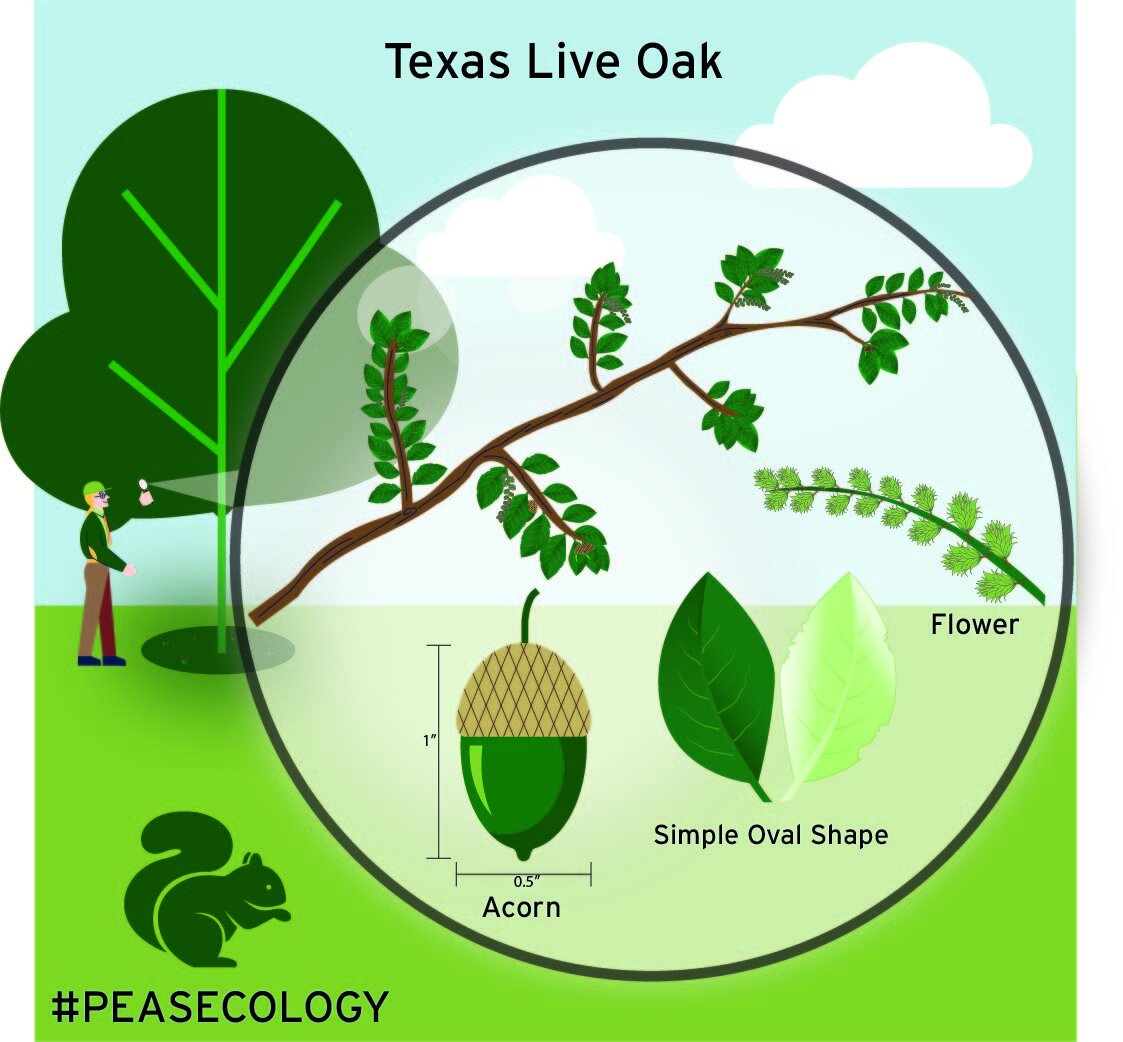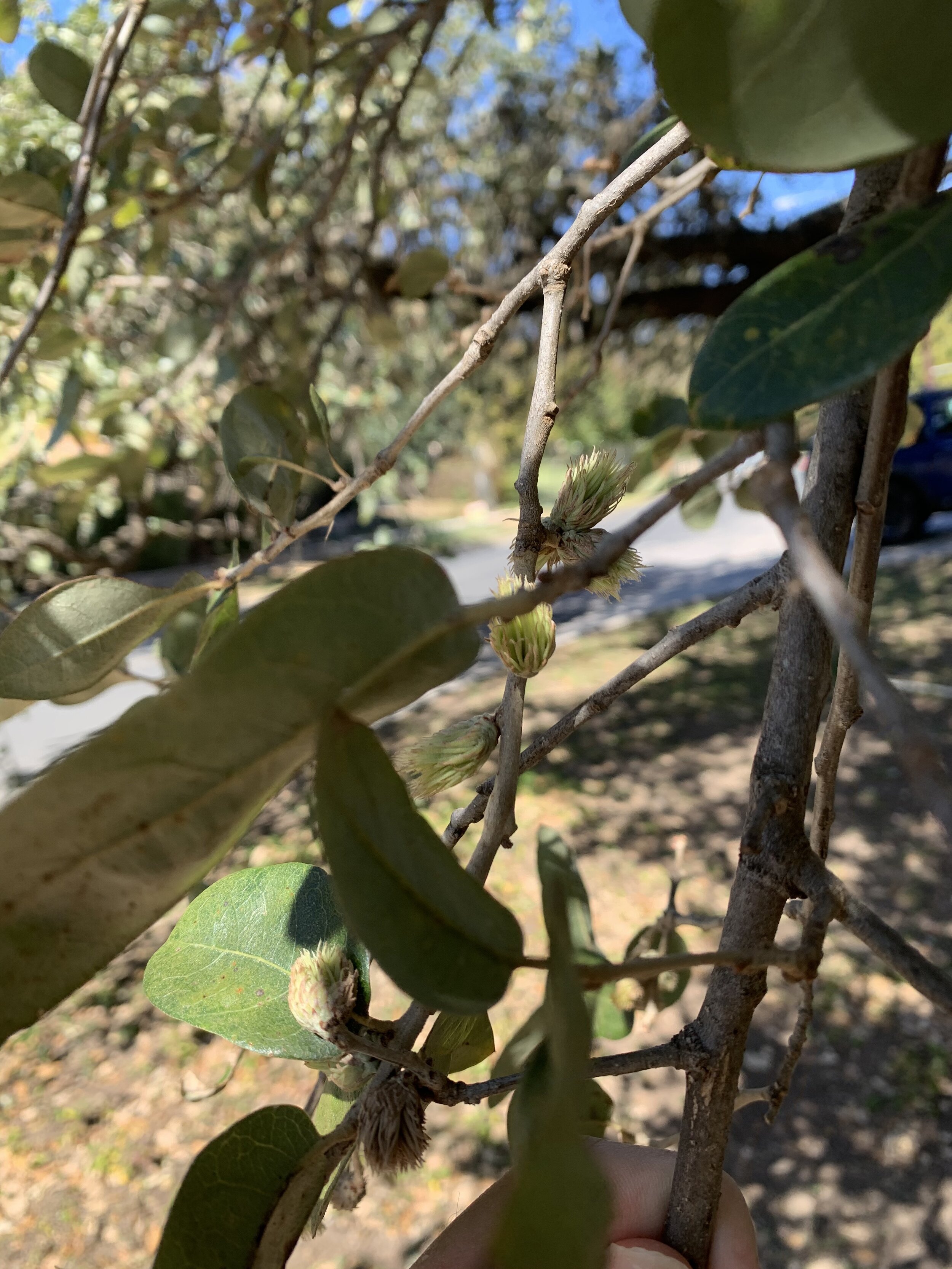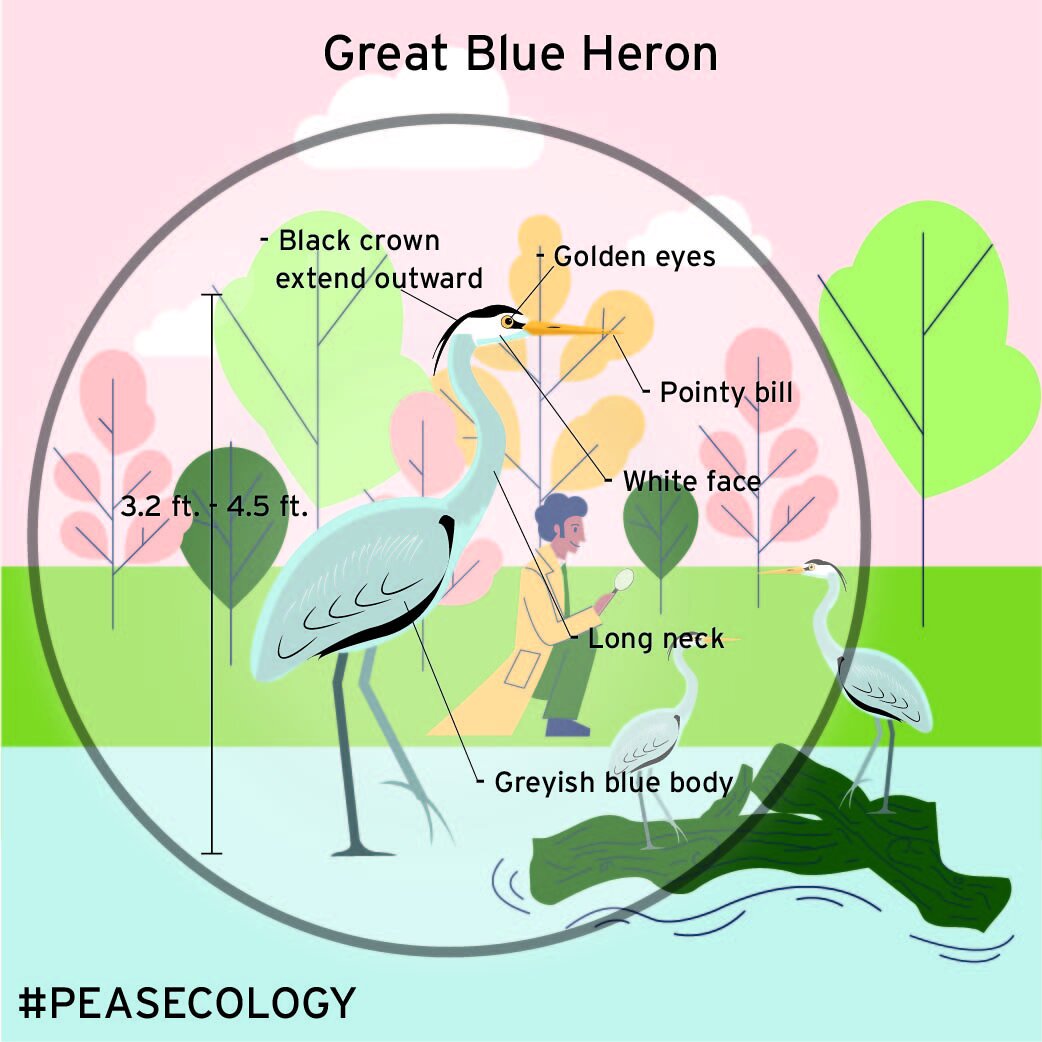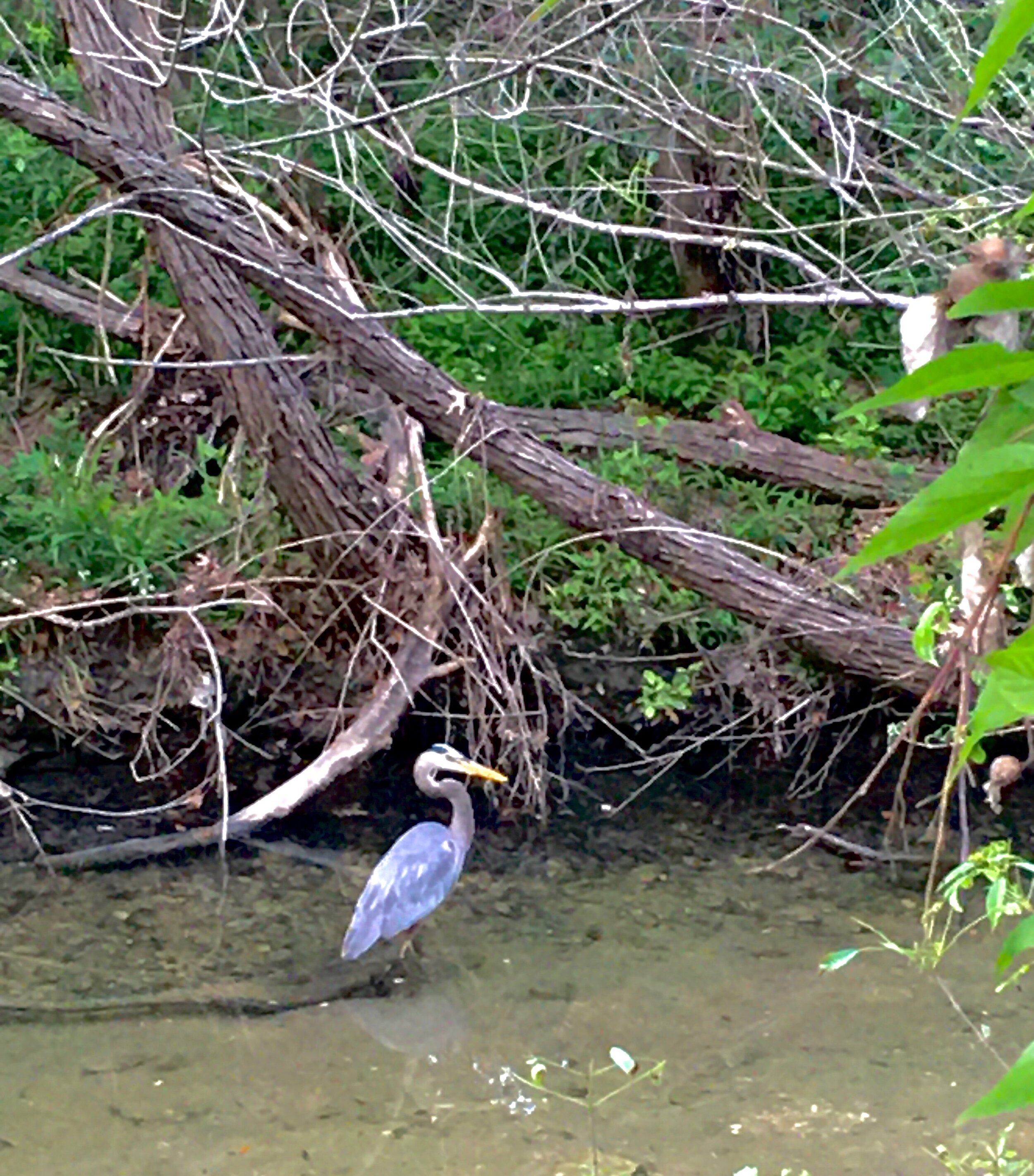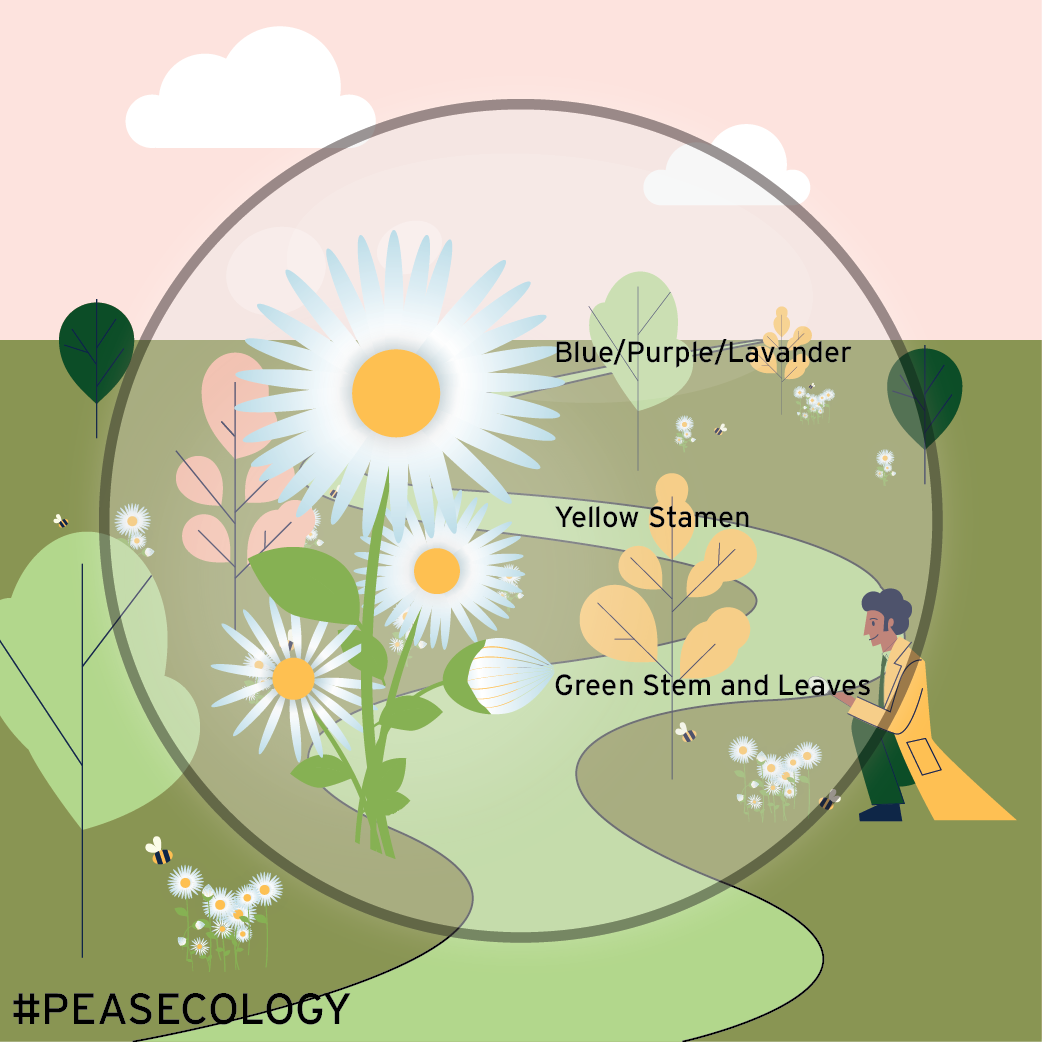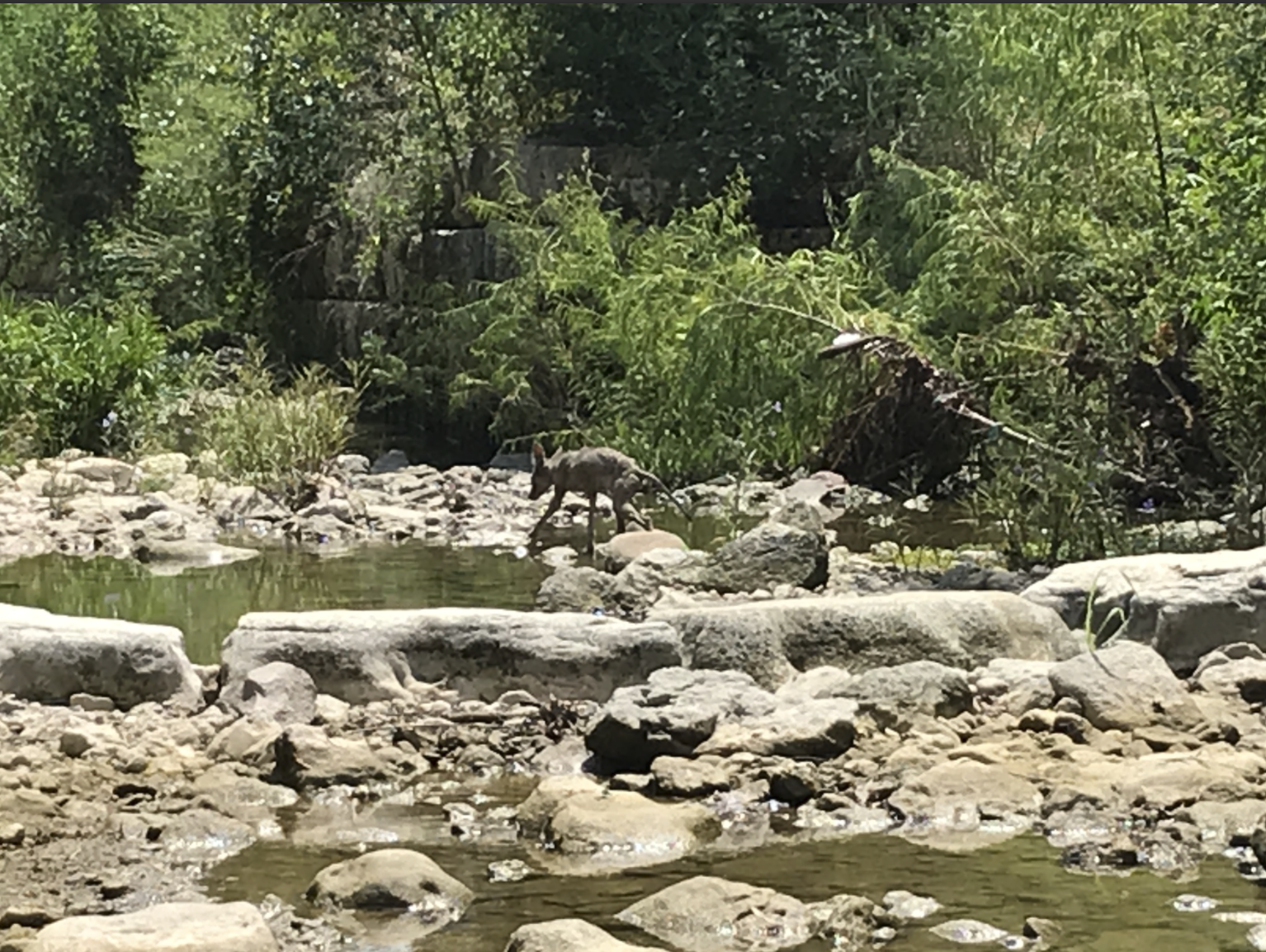#Peasecology
Peasecology is a digital compendium designed to highlight the diverse ecology that lives within Pease Park. Because habitat loss is the number one leading cause of the decline in biodiversity, the intent of Peasecology is to inform the public that in an ever-expanding city like Austin, sustainable conservation of green space, like Pease Park, is also the conservation of countless species’ homes.
A cornerstone of Pease Park Conservancy’s mission is to sustainably manage this invaluable park. So let’s start with learning about what we are protecting.
Curated and Illustrated By:
PPC Communication Intern, Jintao Lin
PPC Sustainability Intern, Emmelie Root
PPC Conservation Coordinator, Nick Boysen
Trees:
Source: Pease Park Conservancy
Texas Live Oak
Tree Description:
Texas Live Oak trees are commonly found in range of 25-50 ft tall and 4 ft trunk in diameter with a low, dense crown that can spread across 100 ft that serves as a good cover under the sun.
Leaf: Simple leaf in oval shape with dark green above and pale and silvery white beneath.
Fruit: An acorn, about 1” long and 0.5” diameter. Dark brown and shiny in oval shape with a gray downy cap about half of its length and a long stem.
Flower: Borne in March - May, flowers can be found in catkins or peduncles in the leaf axils.
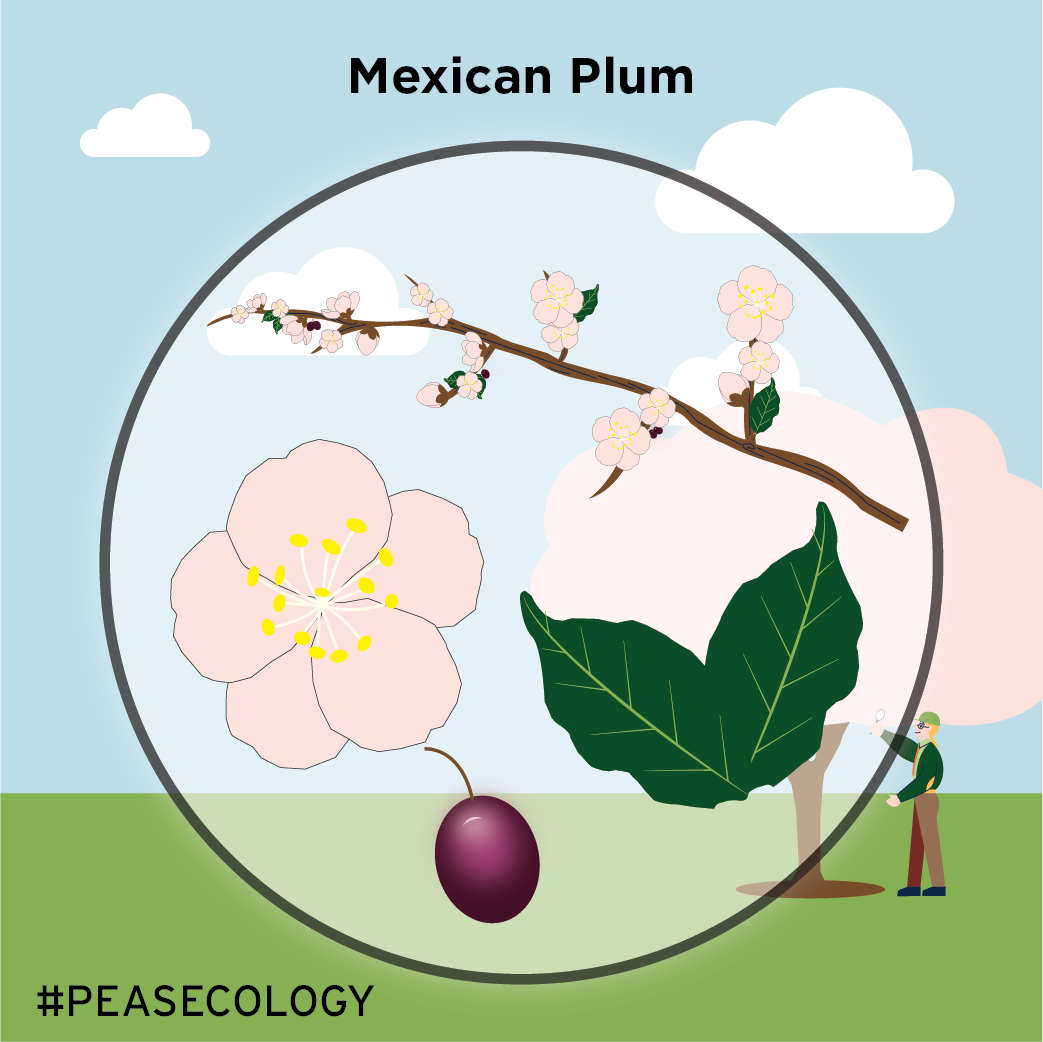
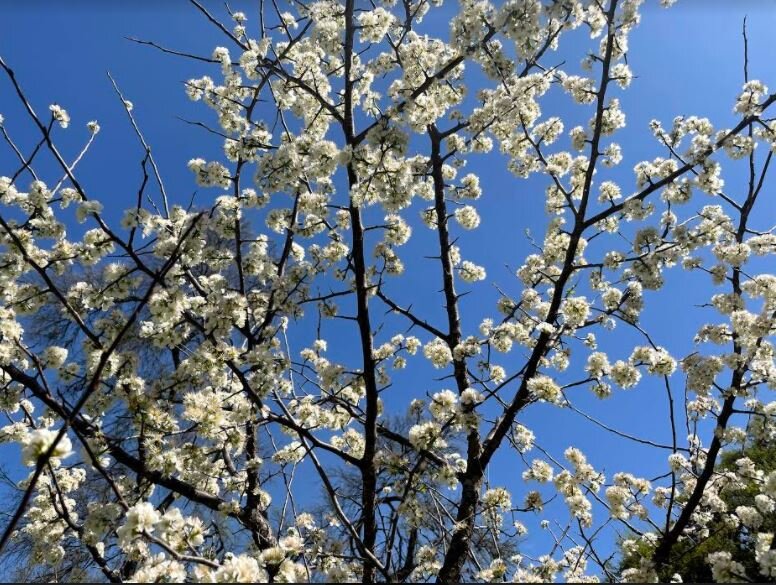
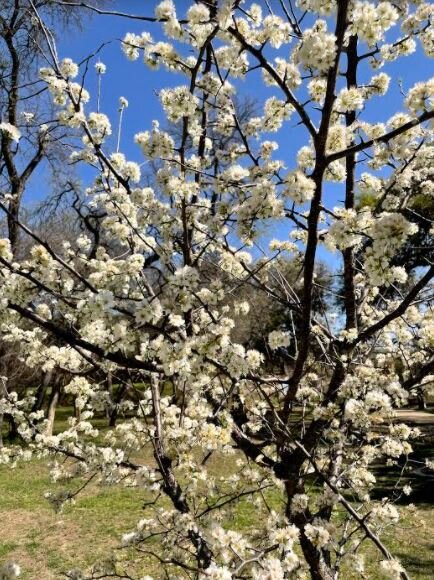
Mexican Plum
Tree Description:
The showy white blooms of Mexican Plum are one of the first signs of spring here in Central Texas. As a native, deciduous tree, it is one of the first ornamental trees to bloom in the spring, showcasing beautiful, fragrant, white flowers. Its flowers are highly attractive to bees and other pollinators, as well as eaten by several species of bird. Fruits ripen in autumn and can be used for preserves and cooking, as well as eaten by local birds and mammals. Mexican Plum can be found all across Pease Park, most notably in Live Oak Meadow and Wooten Woods!
Leaf: Simple, alternate, leaves are ovate to narrower with serrate margins and grow to 5 inches long and 2 inches wide. Green leaves further provide amazing fall color, turning a showy shade of orange.
Fruit: A plum (actually a drupe) that ripens in late summer, 1.25" in diameter, dark purple-red with a bluish "bloom", with a smooth stone 0.75" long under the juicy flesh. Fruits are often used to make jams and jellies.
Flower: Flowers are white to pink in color and bloom between February and April on bare stems, appearing before the tree’s leaves.
Source: Pease Park Conservancy
Birds:
Great Blue Heron
Description:
Great Blue Herons can be found nearby ponds, river banks, and edges of marshes. Characterized with greyish blue body with white face, a long and pointy orangeish bill, and a black crown atop of the head extends backwards.
Average Life Span: 15 years
Size: The size can range from 3.2 feet to 4.5 feet in height and a wingspan from 5.5 feet to 6.6 feet.
Diet: Fish are the most common, however Great Blue Herons also prey on any insects, frogs, lizards, and small mammals like mice.
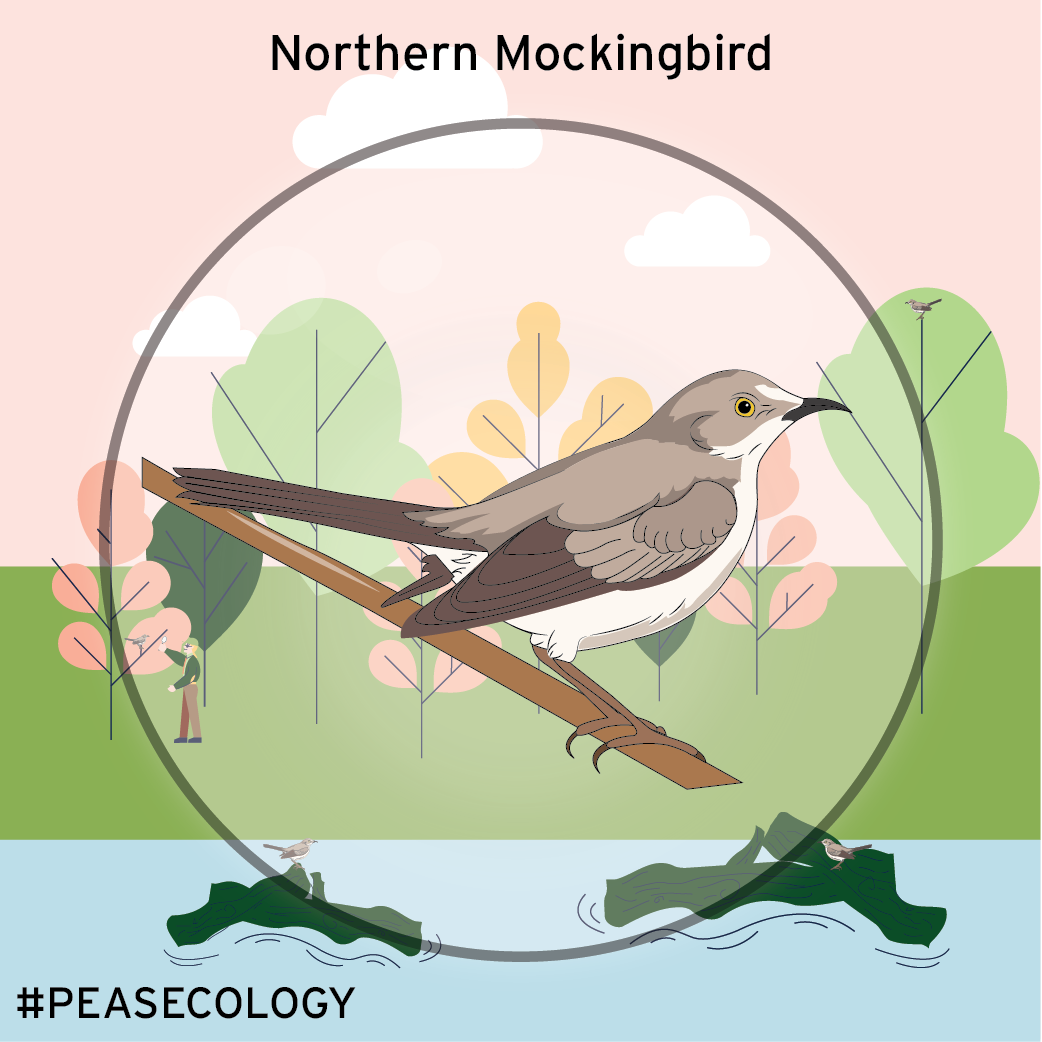
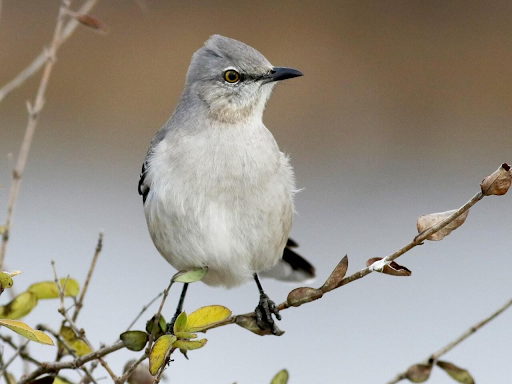
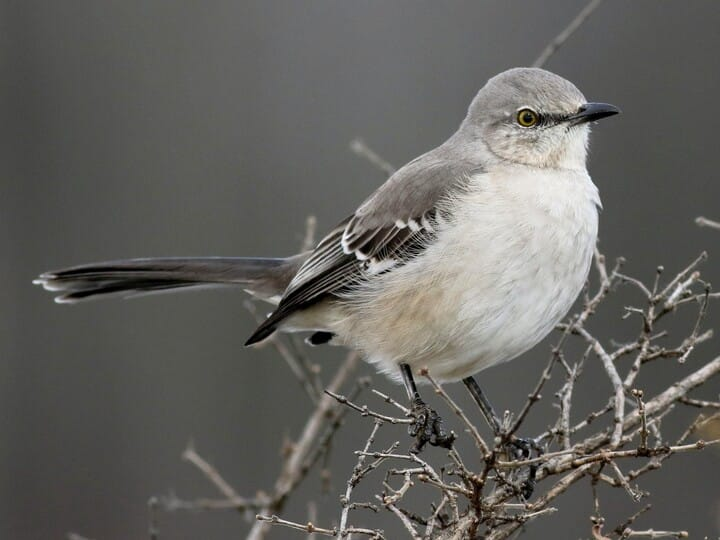
Northern Mockingbird
Description:
The Northern Mockingbird was adopted as the Texas state bird in 1927. It is also the only mockingbird commonly found in North America. This bird is mainly a permanent resident, but northern birds may move south during harsh weather. These thin long-tailed songbirds often sing 10-15 different songs in succession and can be heard in a variety of open habitats, including backyards. Northern Mockingbirds are not shy and often sing from an open high perch, or can be seen running or hopping across the ground chasing insects. They also will aggressively defend their territory from other birds, people, and even squirrels.
Size & Shape: A medium-sized songbird, a bit more slender than a thrush and with a longer tail. Mockingbirds have small heads, a long, thin bill with a hint of a downward curve, and long legs. Their wings are short, rounded, and broad, making the tail seem particularly long in flight.
Color Pattern: Mockingbirds are overall gray-brown, paler on the breast and belly, with two white wing bars on each wing. A white patch in each wing is often visible on perched birds, and in flight these become large white flashes. The white outer tail feathers are also flashy in flight.

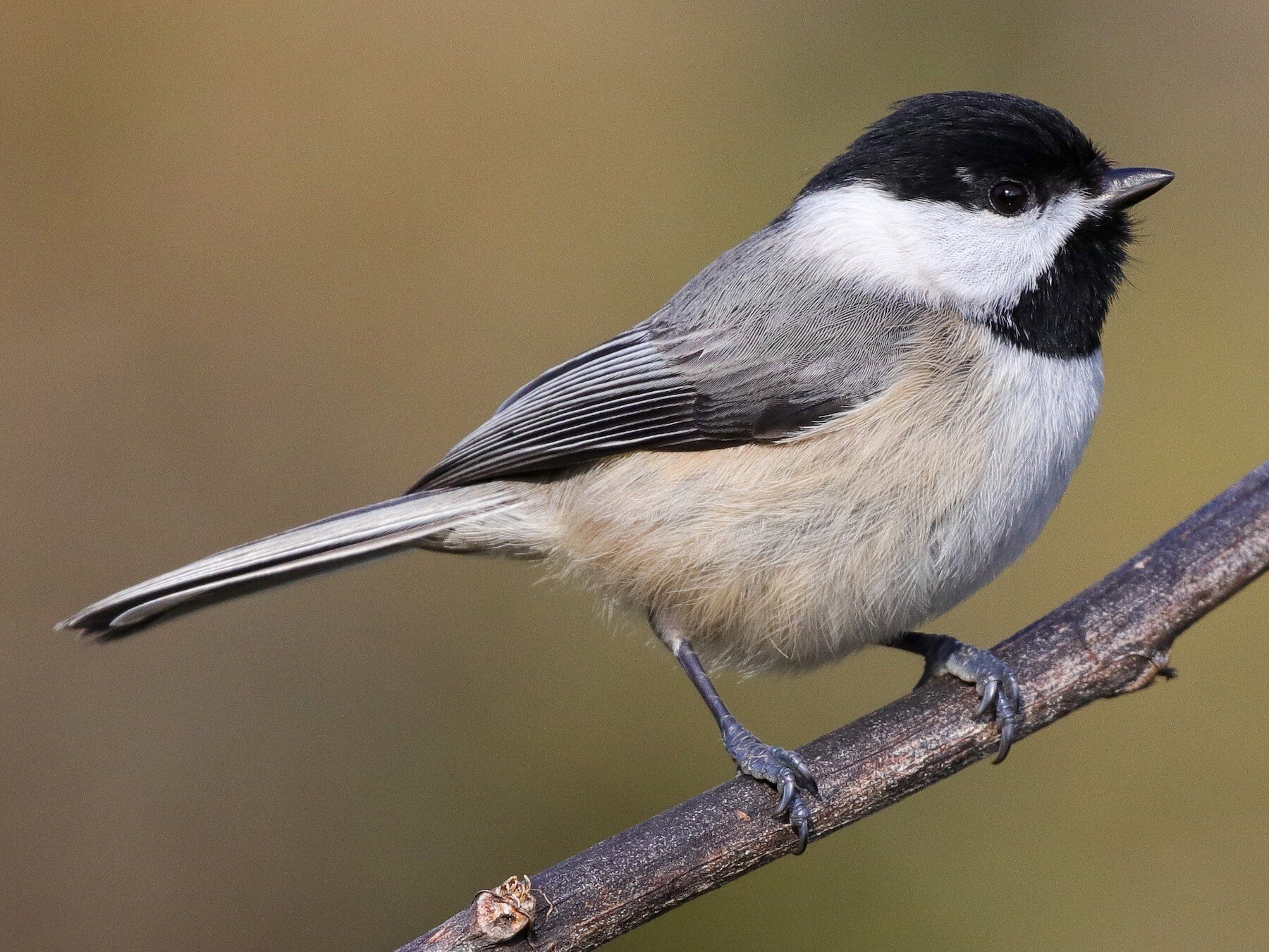
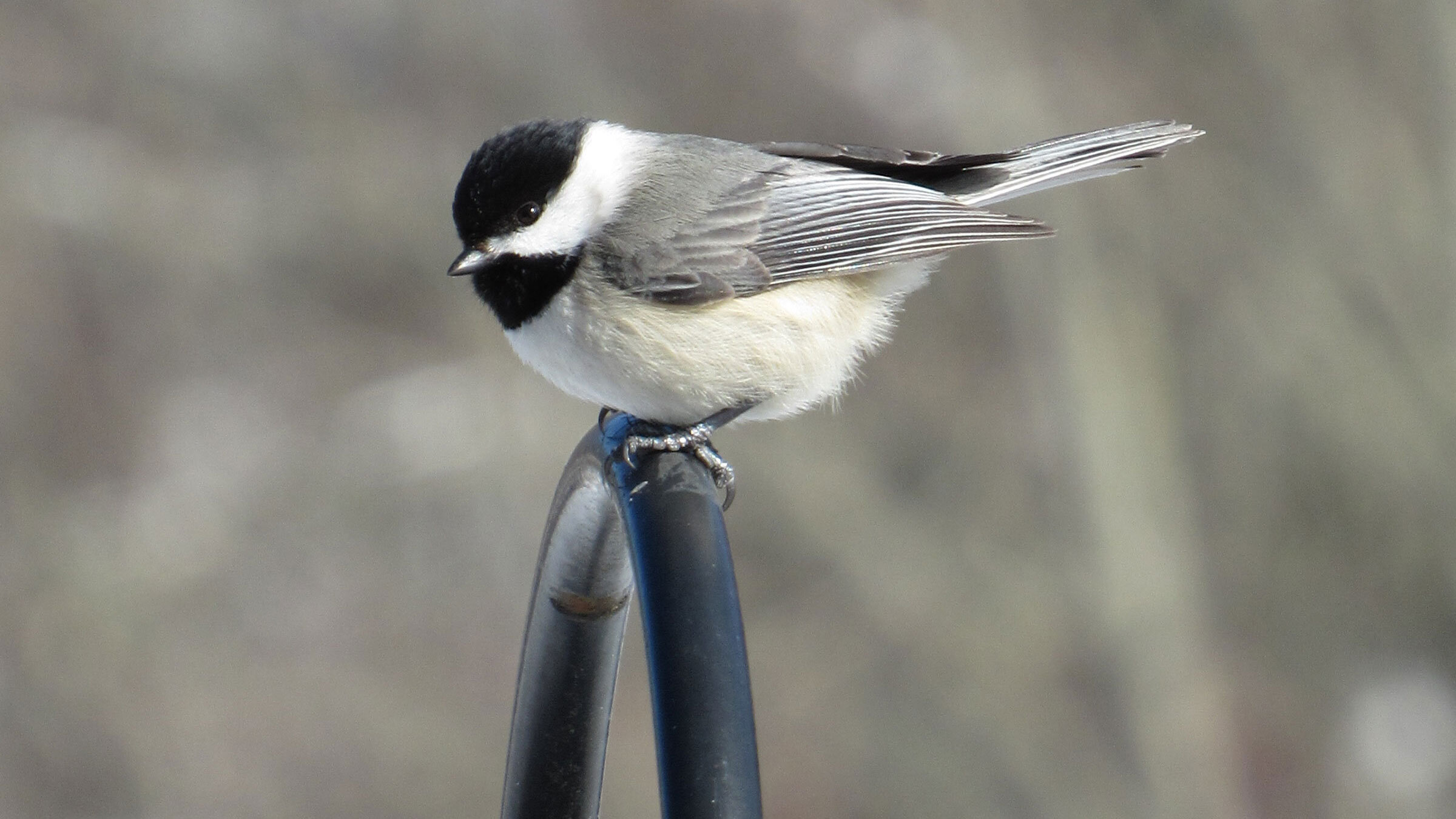
Carolina Chickadee
Characteristics:
Adults have a black cap and bib with white sides to the face. Their underparts are white with rusty brown on the flanks; their back is grey. They have a short dark bill, short wings, and a moderately long tail.
Habitat: Carolina Chickadees may be found in deciduous and mixed deciduous-coniferous woodlands, swamps, riparian areas, open woods and parks, and also in suburban and urban areas.
Diet : Animals (mostly insects and spiders) make up the majority of the Carolina Chickadee’s diet. They eat more plants in the winter. Carolina Chickadees glean insects from foliage and tree bark, often hanging upside down to do so.
Interesting Facts: In winter, Carolina Chickadees live in flocks of two to eight birds and defend areas against other flocks. Dominant birds in these flocks establish breeding territories in the summer that were part of the winter flock's range.
Wildflowers:
Source: Pease Park Conservancy
Spreading Aster
Description:
Spreading Aster is one of native wildflowers in Texas. Bloom in August and through October. Often found in woodland areas like Pease Park with its tolerance in shades.
Scientific Name: Symphyotrichum Patens
Colors:
- Blue/Purple/Lavander Petals
- Yellow Stamen
- Green Stems and Leaves
Wildlife Values: Attracts bees and butterflies to the area.
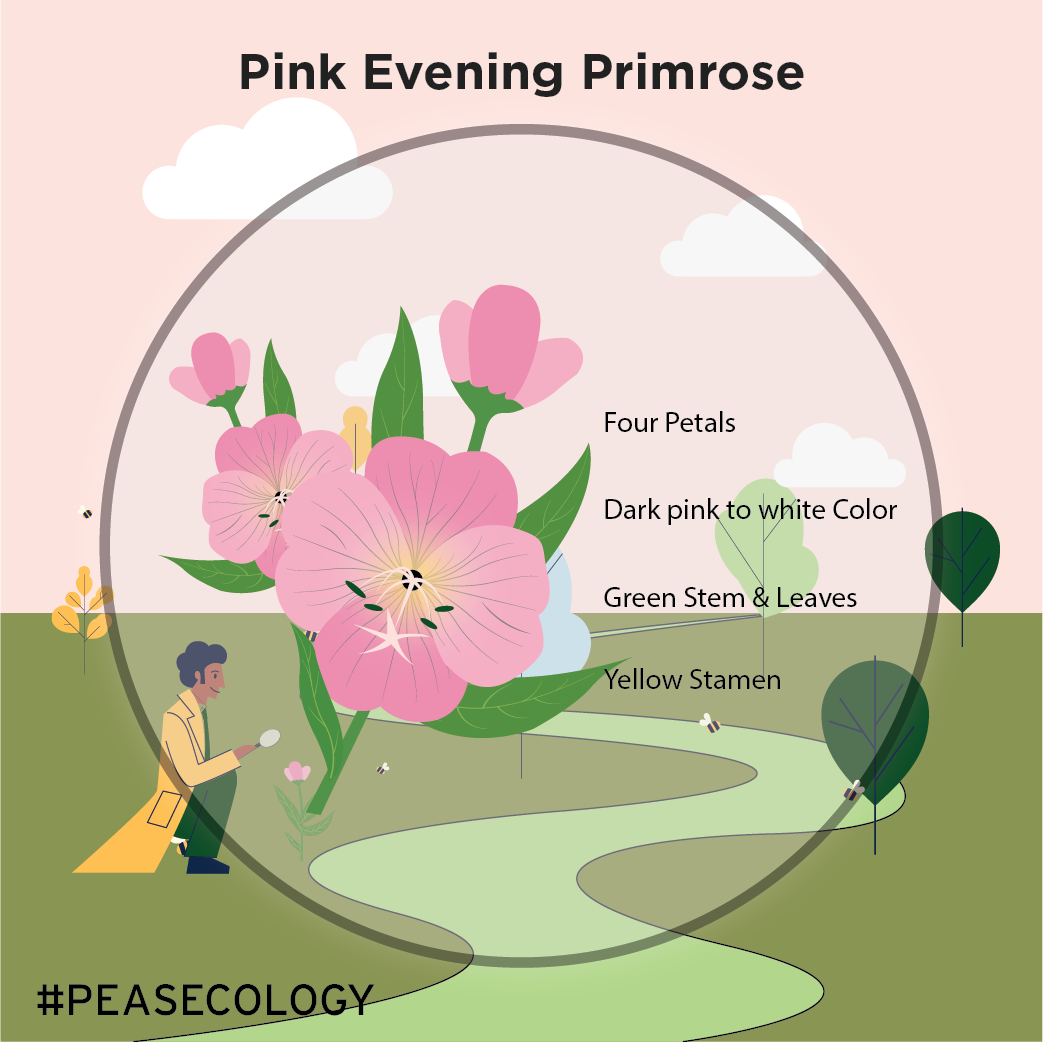
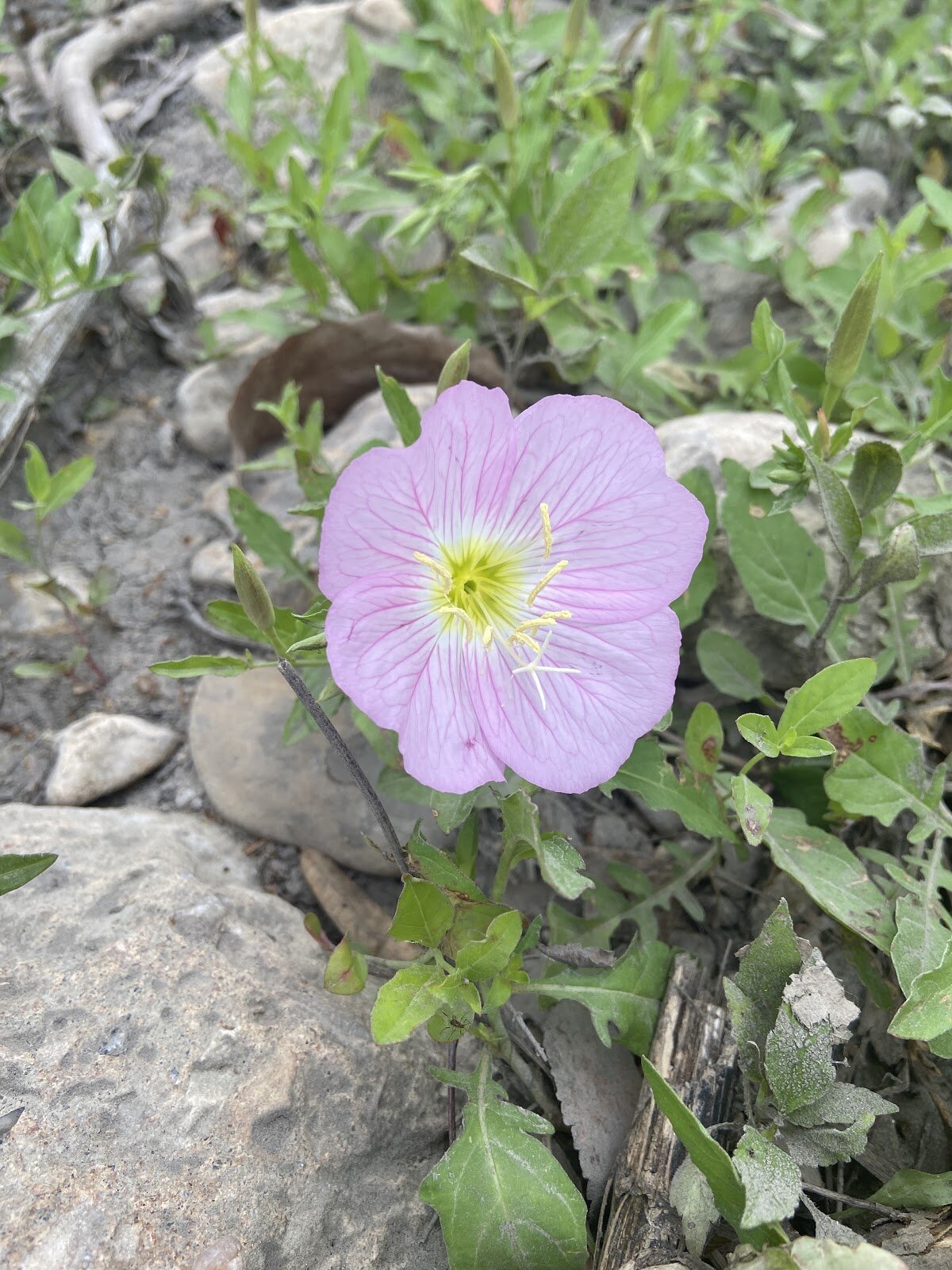
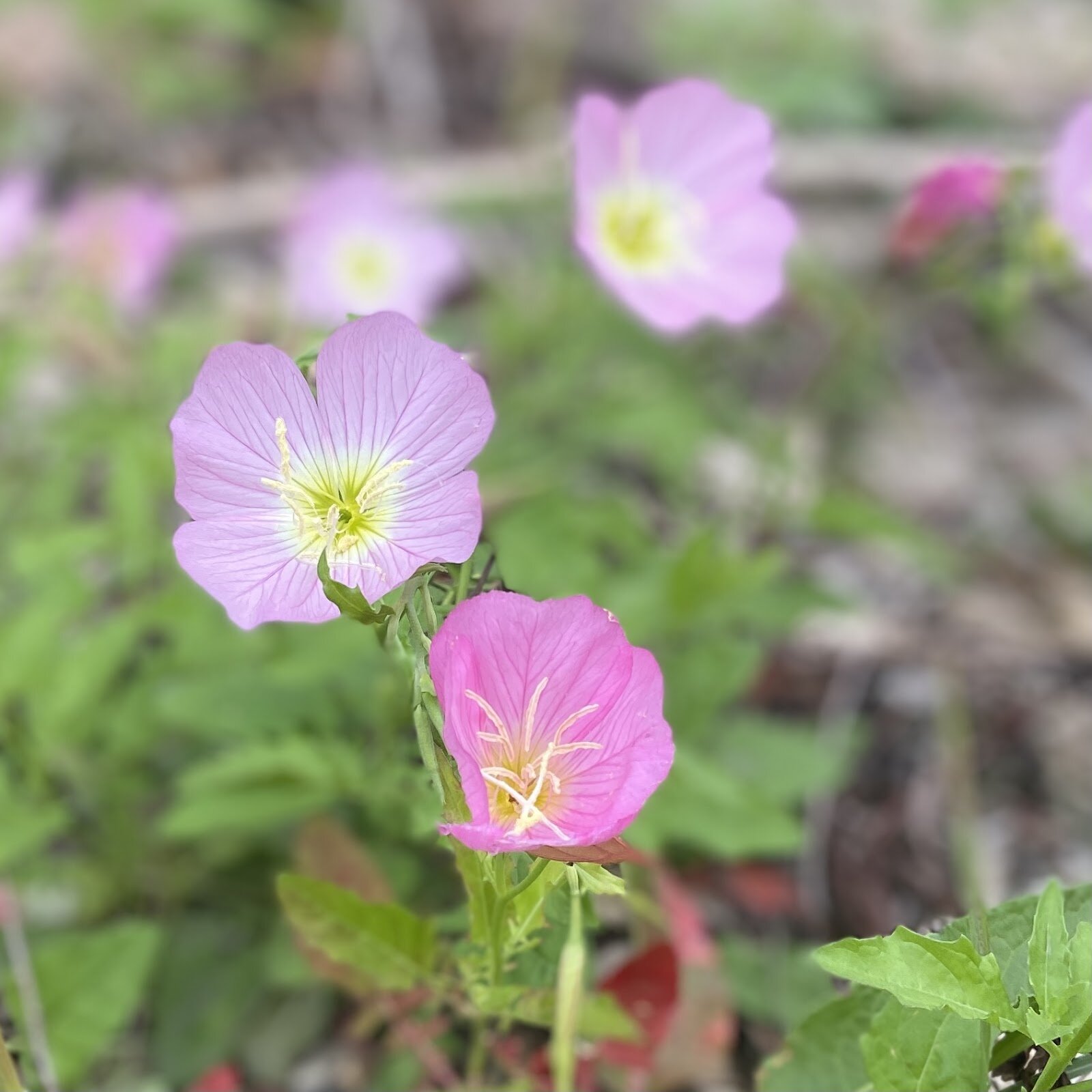

Source: Pease Park Conservancy
Pink Evening Primrose
Description:
Pink evening primrose is a native wildflower to the prairies of Texas. It is a perennial, which spreads to form extensive colonies. Its large, four-petaled flowers, solitary from leaf axils, range in color from dark pink to white. As the common name implies, most evening primrose species open their flowers in the evening, closing them again early each morning. The flowers of some members of the genus open in the evening so rapidly that the movement can almost be observed. Pink evening primrose populations in the southern part of its natural range (Texas), however, open their flowers in the morning and close them each evening.
Scientific Name: Oenothera Speciosa
Colors:
- White to Light Pink Petals
- Yellow Stamen
- Green Stems and Leaves
Wildlife Values: Attracts several species of insects, most notably moths.
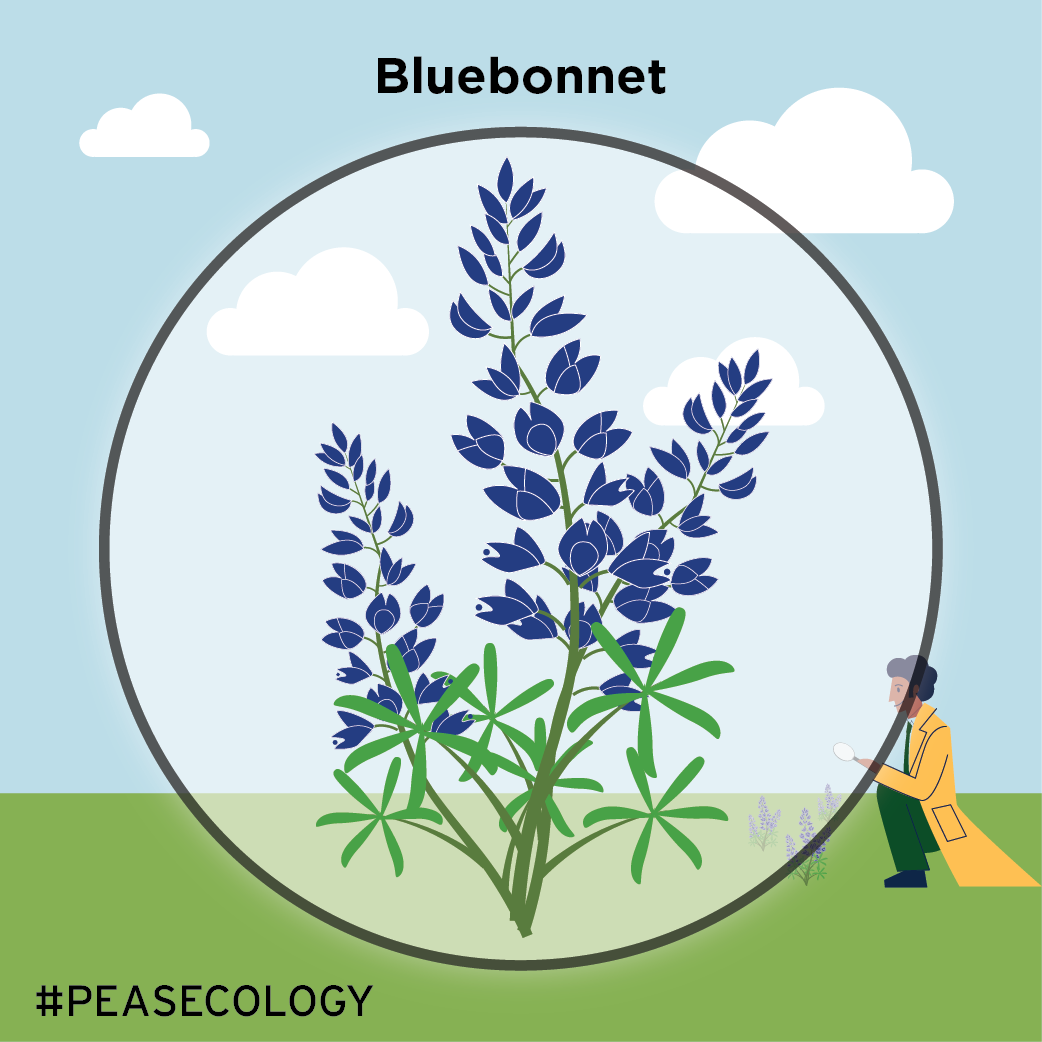
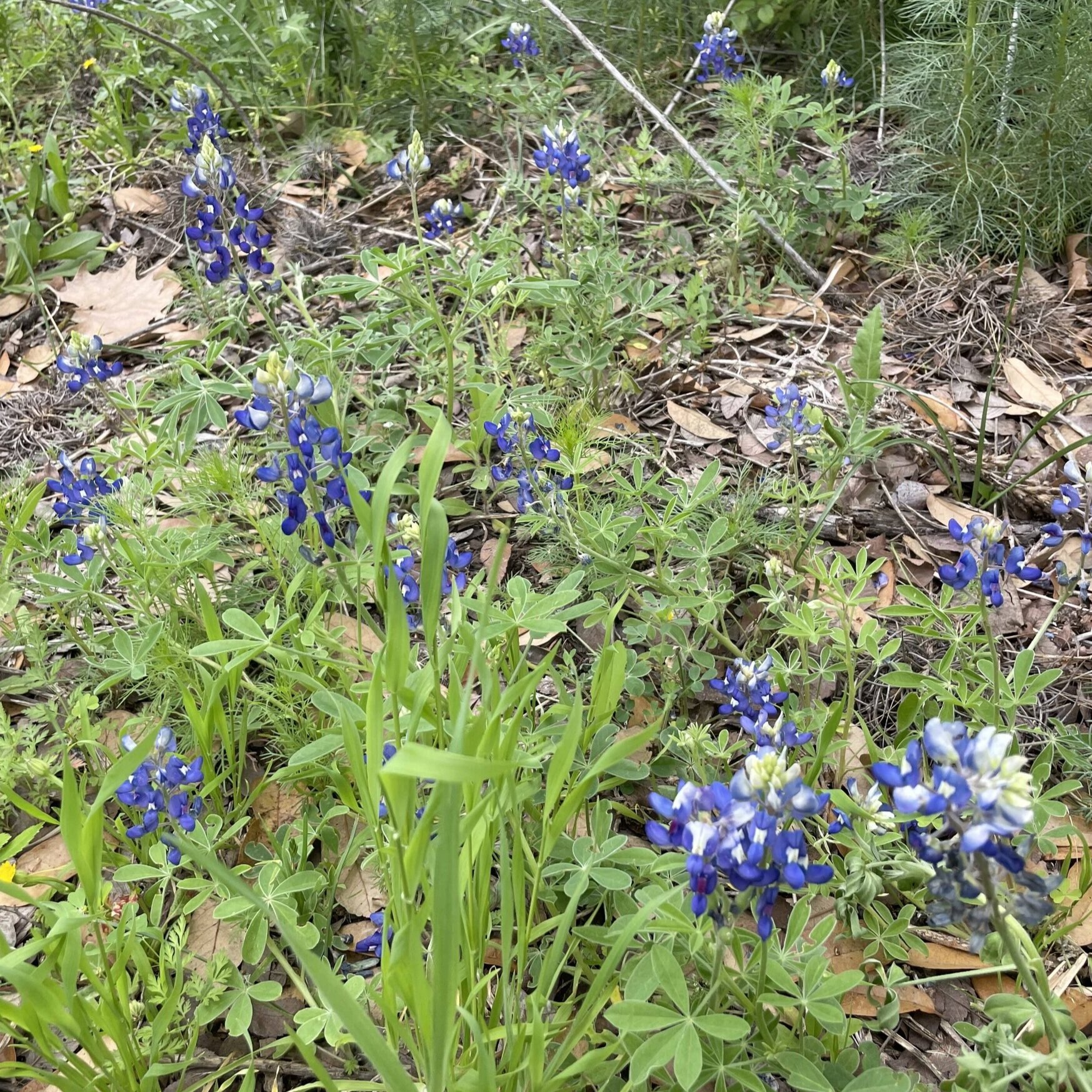
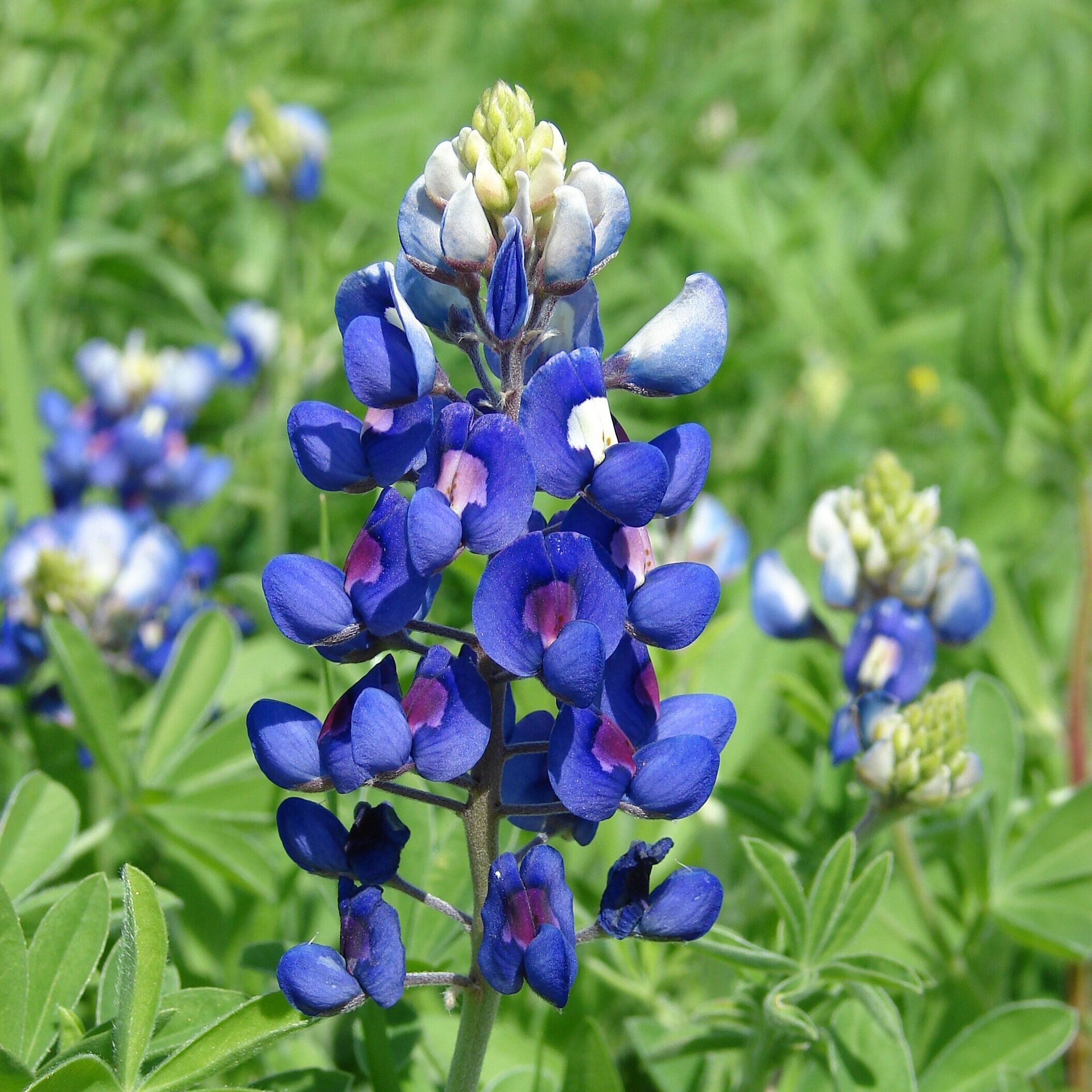

Source: Pease Park Conservancy, Wikipedia
Bluebonnets
Description:
Texas Bluebonnet, Lupinus texensis, is the most iconic spring bloom in Texas. It is one of five Bluebonnets recognized as the Texas State Flower; the other four being L. subcarnosus, L. havardii, L. concinnus and L. plattensis. The five lupine species grow in different areas of Texas, while Lupinus texensis is most prominent in Central Texas, found within garden beds, along roadsides and throughout pastures. Much like the Mexican Plum, flowering Bluebonnets let us know spring has arrived in Texas, as one of the first native wildflowers to bloom for the season. You can find Bluebonnets across Pease Park, but especially within the wildflower meadow at Lamar Terrace (the corner of N Lamar Blvd and 29th St), and all along the roadside of North Lamar!
Scientific Name: Lupinus texensis
Colors:
- Blue flowers with white accents
- Green Stems and Leaves
Wildlife Values: Texas Bluebonnets are highly beneficial to native bees, specifically Bumble Bees, as well as acts as a larval host for Hairstreak and Elfin butterflies.

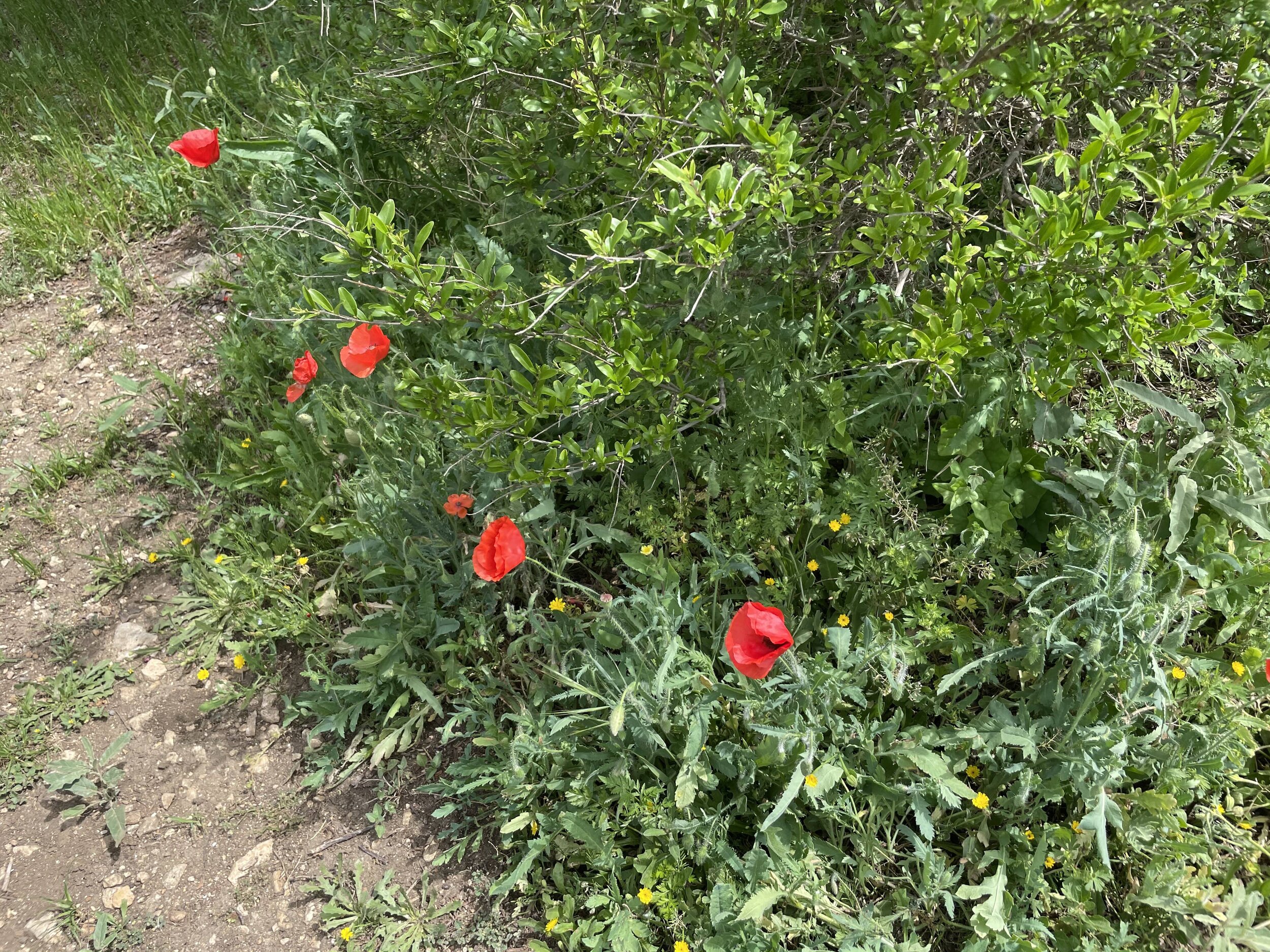
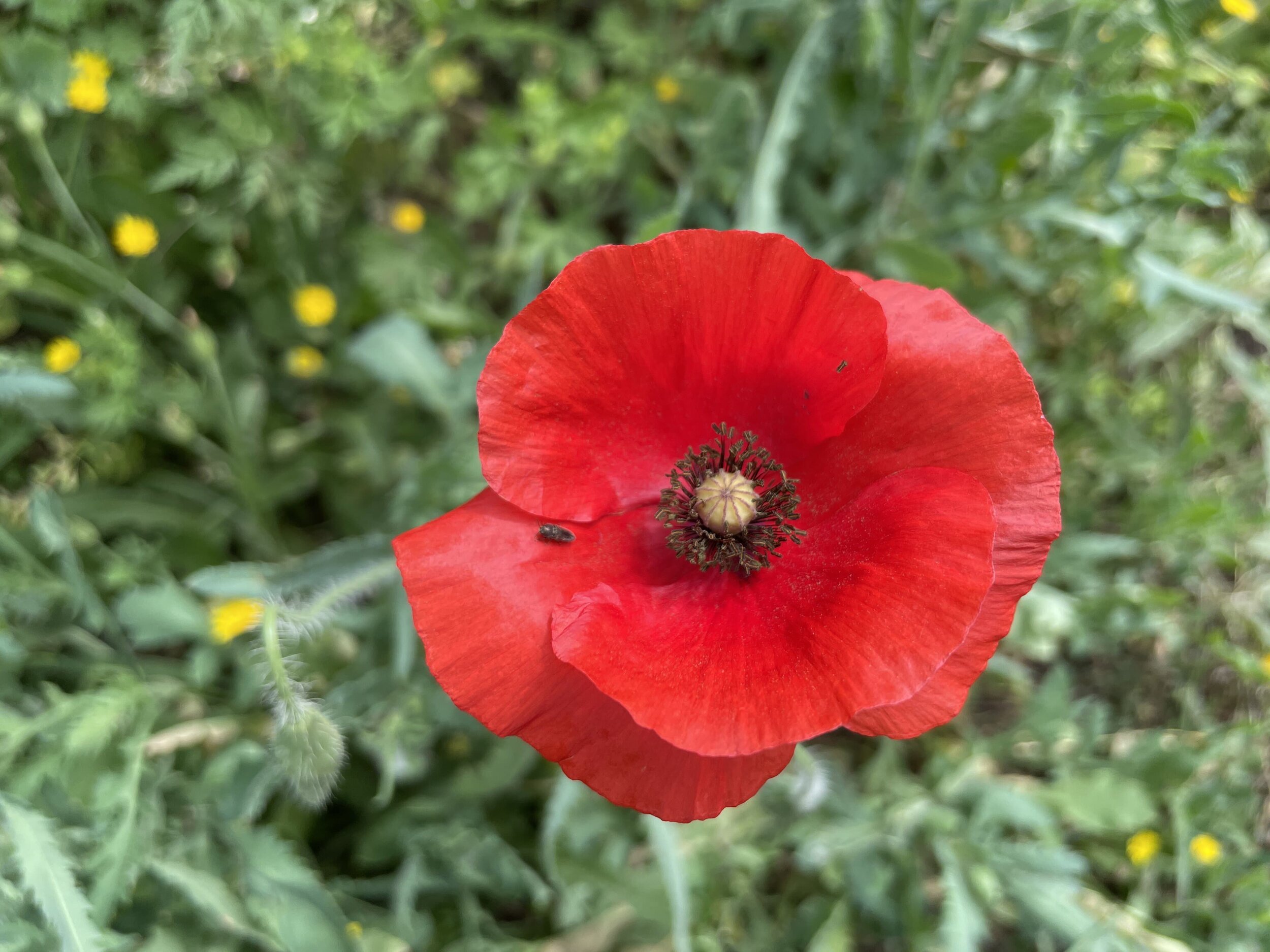
Common Poppy
Description:
Common Poppy, Papaver rhoeas, is an annual herbaceous species of flowering plant in the poppy family native to Europe, Asia, and Northern Africa, and ranges from being invasive to naturalized throughout the United States. Common Poppies grow in clumps up to 24 in. tall and 12 in. wide, with bright red flowers, 3-4 in. wide. They prefer full-sun and rich, well-drained soils, and can often be found along roadsides, field edges, and cultivated gardens.
Scientific Name: Papaver rhoeas
Colors:
- Usually red, but flowers can also be purple or white.
- Green Stems and Leaves
Cultural Significance: In Persian literature, red poppies, especially red corn poppy flowers, are considered the flower of love. They are often called the eternal lover flower. In classic and modern Persian poems, the poppy is a symbol of people who died for love.

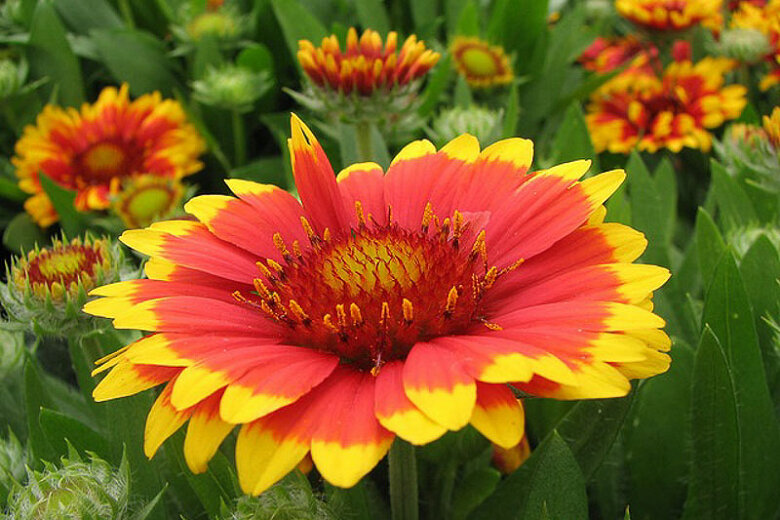

Indian Blanket
Description:
Gaillardia pulchella, more commonly known as Indian blanket, is a North American species of short-lived perennial or annual flowering plants in the sunflower family. Indian blanket is a hardy plant, not picky about soil, though sandy and well-drained are best. It has a high drought tolerance and enjoys a dry, hot climate in full sun. Growing to be about 12-24” tall, this bold native wildflower can be found in meadows, along highways, and in garden spaces from early summer to late fall. Especially vibrant bunches of Indian blanket have already been spotted at Pease Park within the meadow at Caswell Shoals (near the corner of N. Lamar Blvd and W 24th St.).
Scientific Name: Gaillardia pulchella
Colors:
- Red, Yellow, Brown.
- Green Stems and Leaves
Wildlife Values: Indian Blanket is a larval host to the bordered patch butterfly (Chlosyne lacinia) and the painted schinia moth (Schinia volupia), which feed upon its foliage.
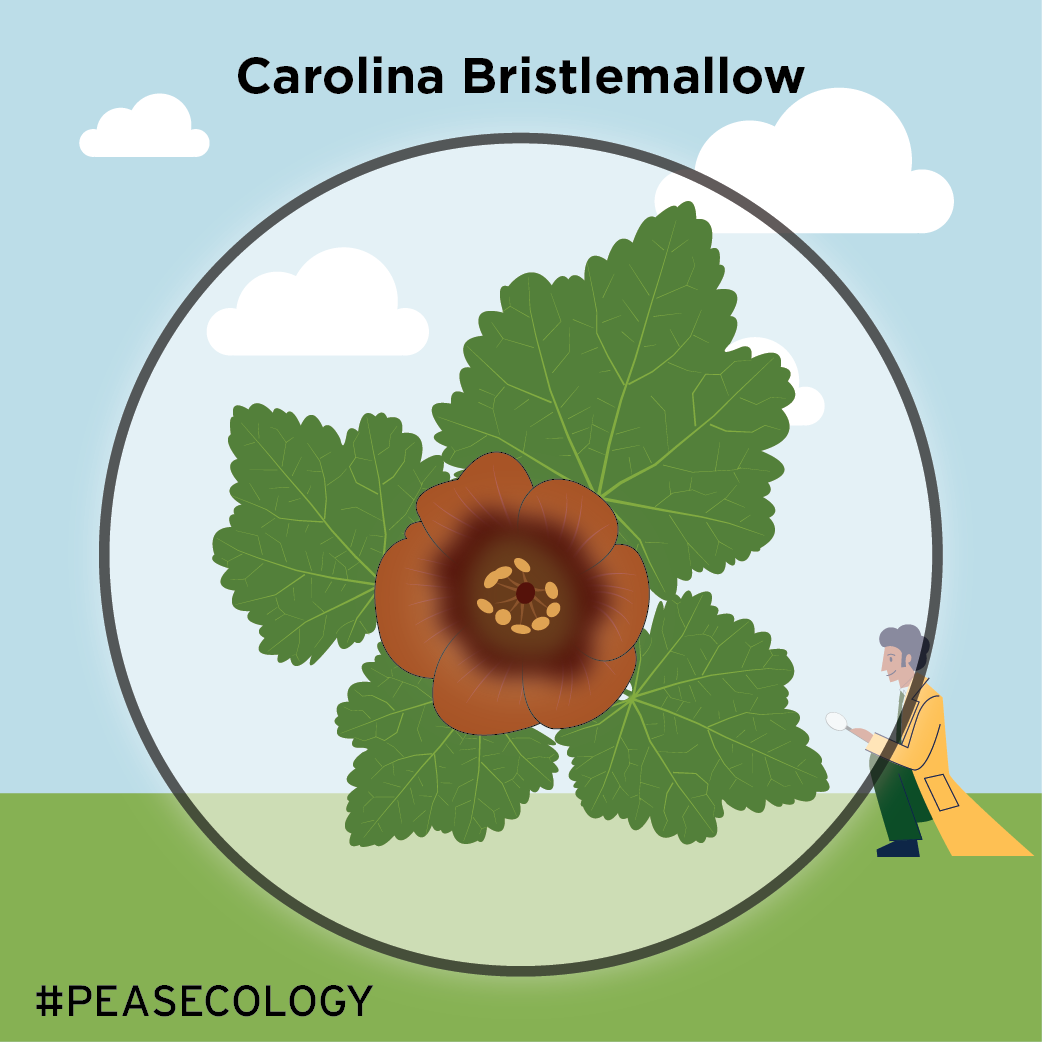
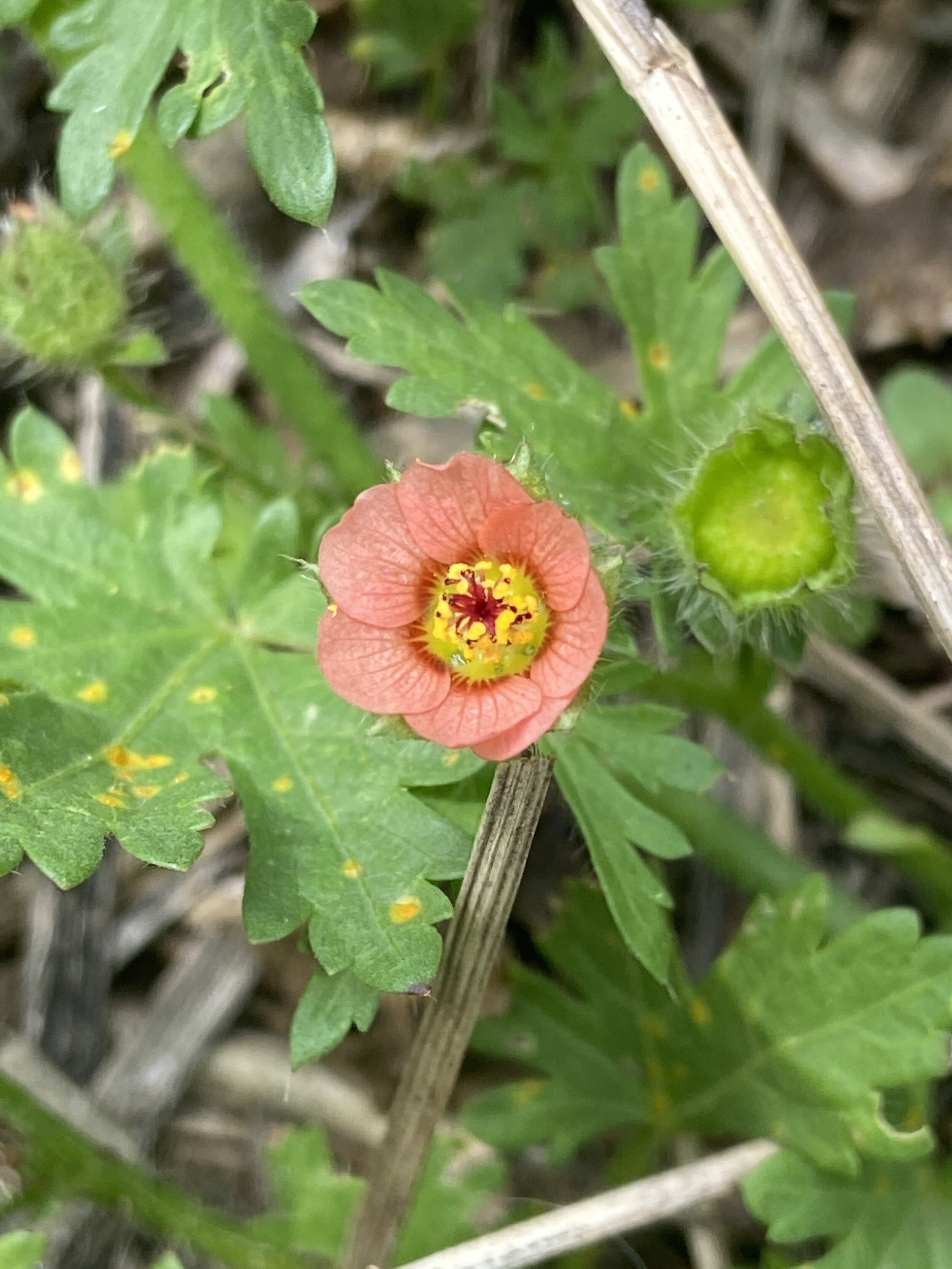
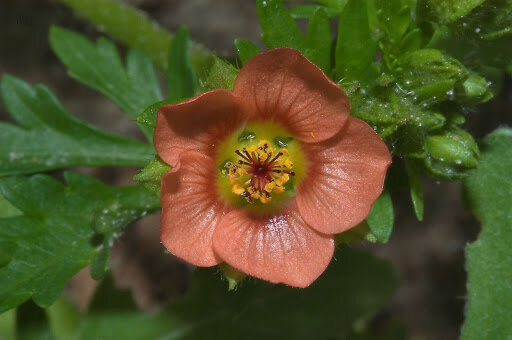
Carolina Bristlemallow
Description:
Carolina Bristlemallow is a low creeping perennial, likely native to South America but is widely naturalized throughout the tropical and warmer temperate world. It is considered native in Texas, and can be found within both desert and riparian ecosystems. It is often referred to as a weed, and typically grows in urban lawns and gardens and in disturbed areas where it can get some extra water. Carolina Bristlemallow requires full sun and is drought tolerant, making it a great addition to any xeric garden.
Scientific Name: Modiola caroliniana
Colors:
- Reddish pink, pinkish orange flowers
- Green Stems and Leaves
Flowering Season: Spring, Summer
Reptiles and Amphibians :
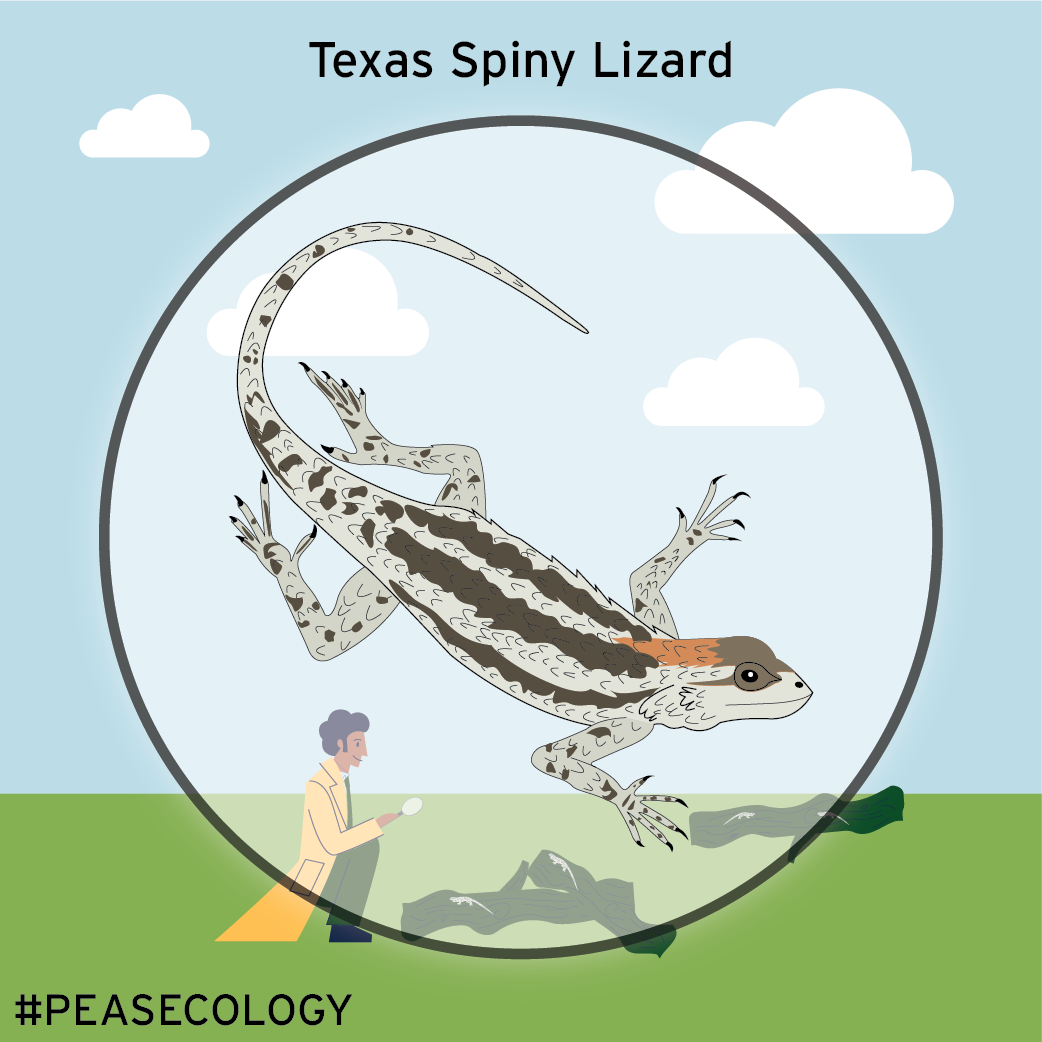
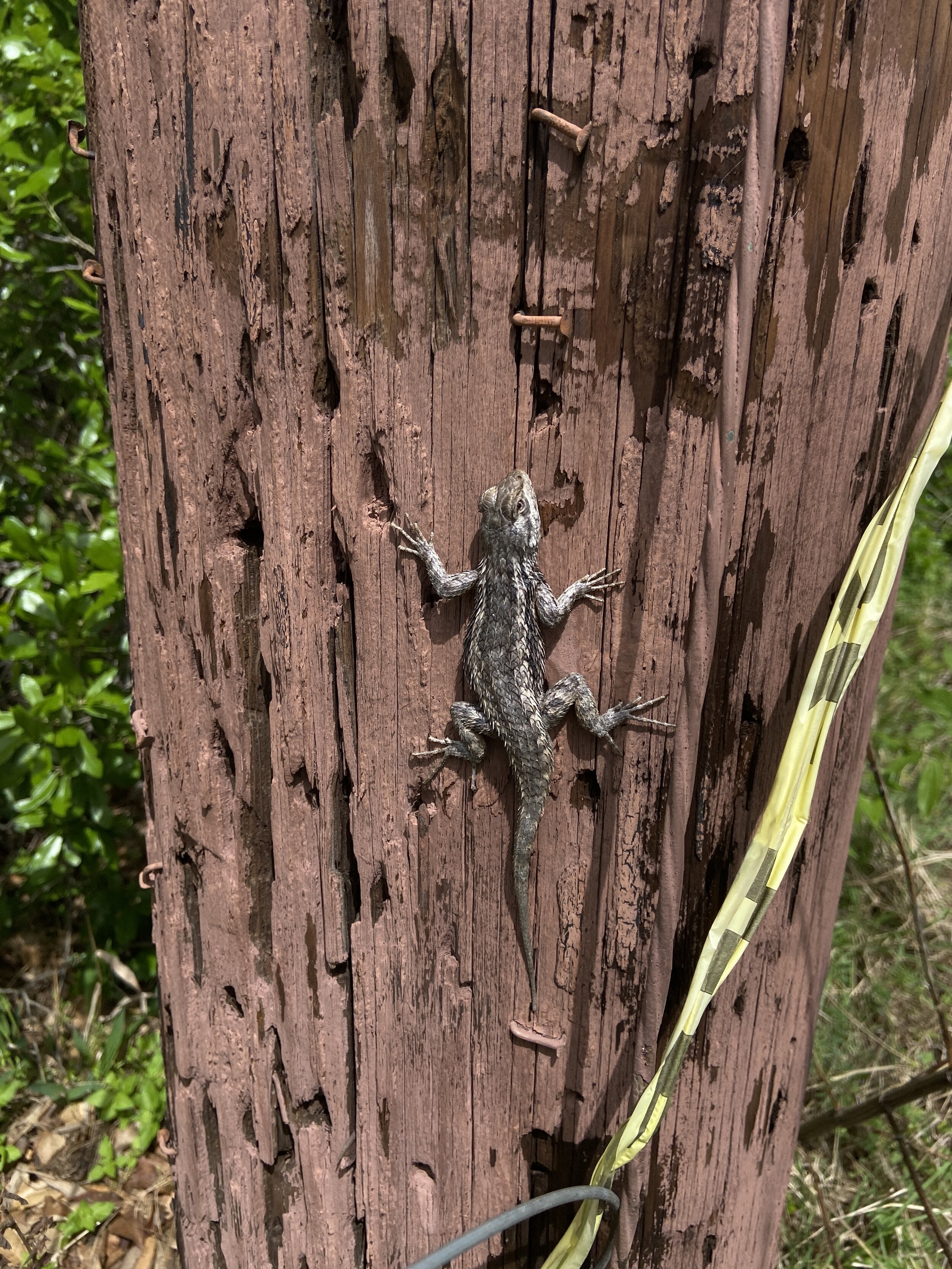
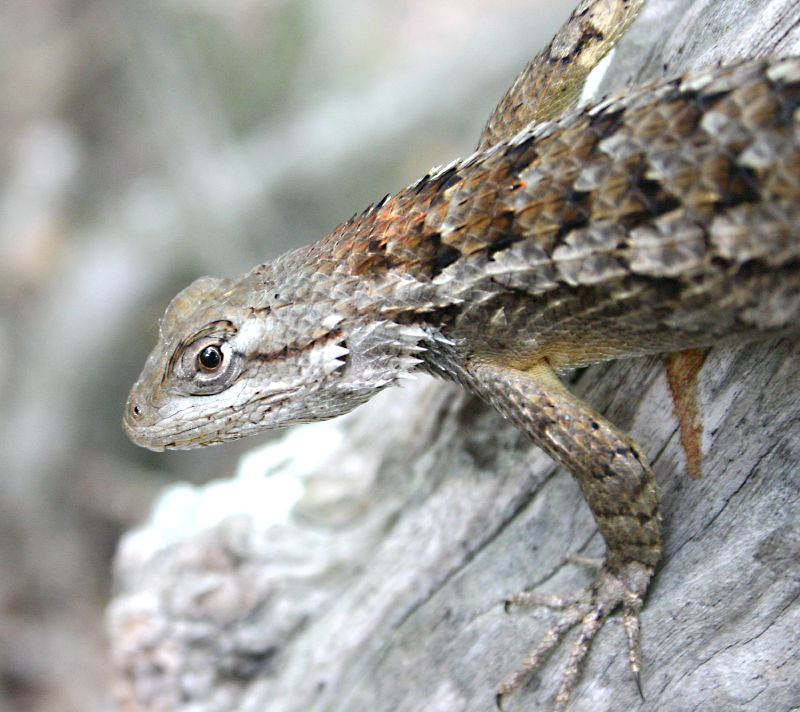
Texas Spiny Lizard
Description:
Texas spiny lizards are small lizards native to the south-central United States, and are one of the most commonly seen lizards in Texas, often found in trees or on fences. Typically shy and nervous, when approached they will usually retreat up a tree or flee noisily through leaf litter on the ground. They are insectivorous, and eat a variety of beetles and other insects.
Scientific Name: Sceloporus olivaceus
Identification:
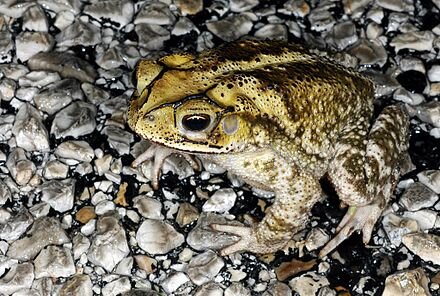
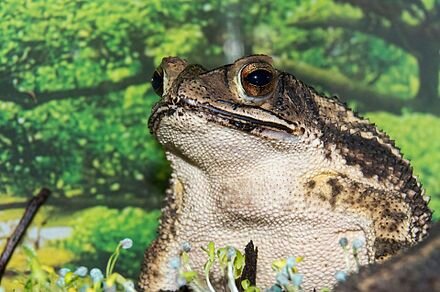
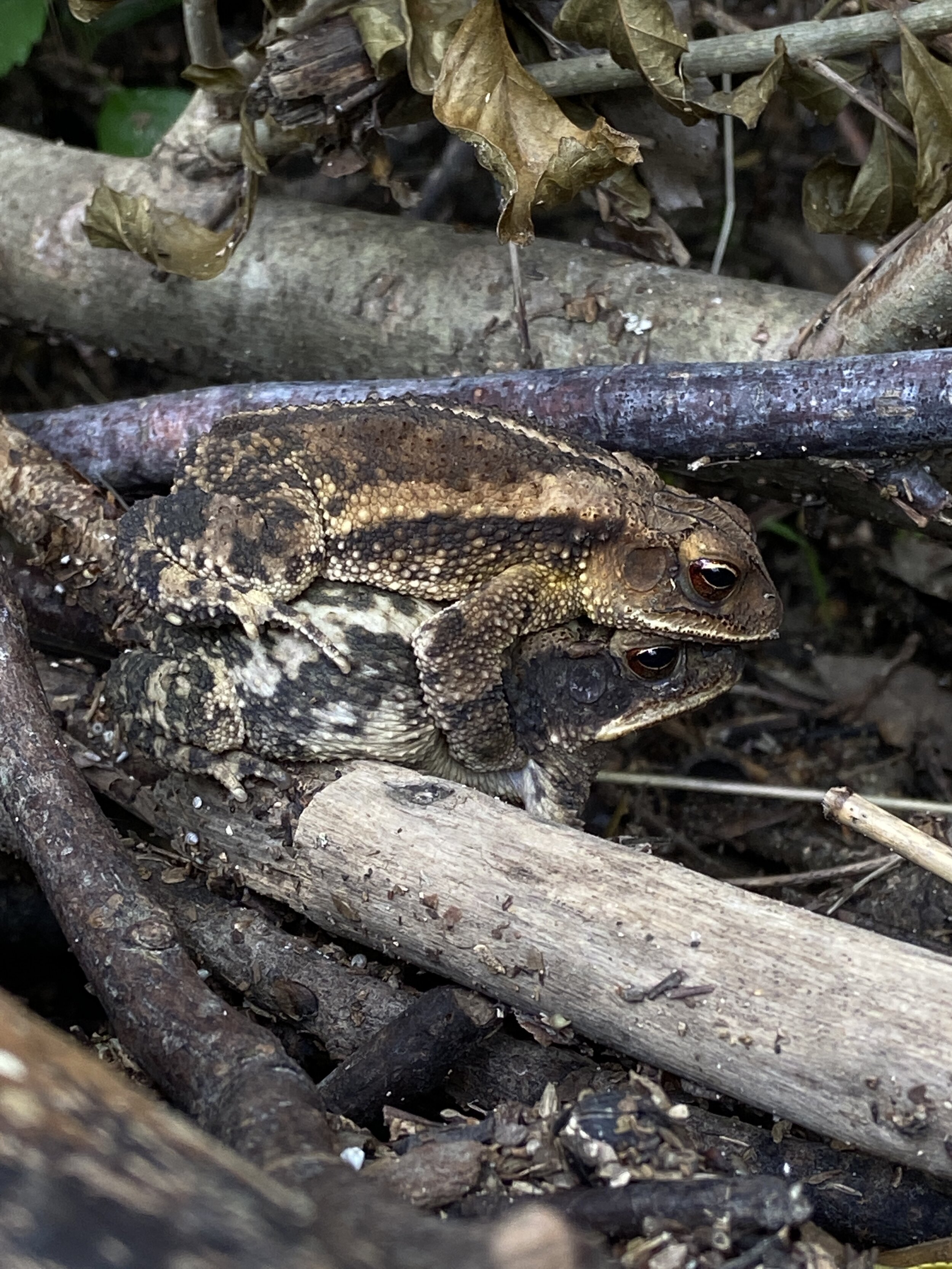
Gulf Coast Toad
Description:
The Gulf Coast toad is a medium-sized toad species. Their back varies in color from nearly black, to shades of brown and grey with a distinctive white or yellowish colored stripe down the center, and sometimes lighter-colored patches on the sides. Their underside is yellow or cream-colored. Their back is covered in small bumps
Scientific Name: Incilius valliceps
Diet and Habitat:
Interesting Fact:
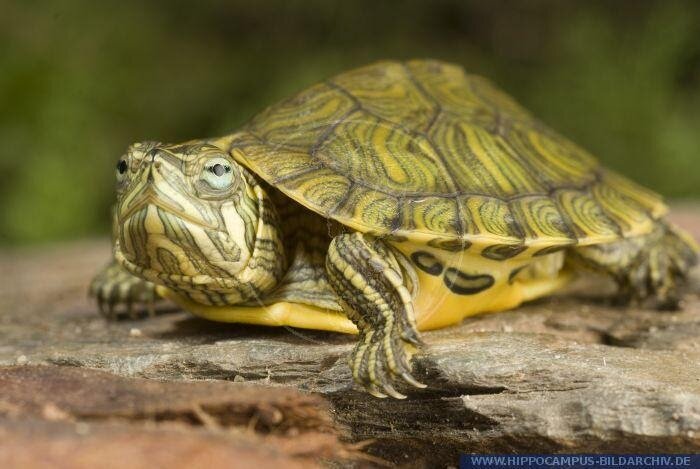
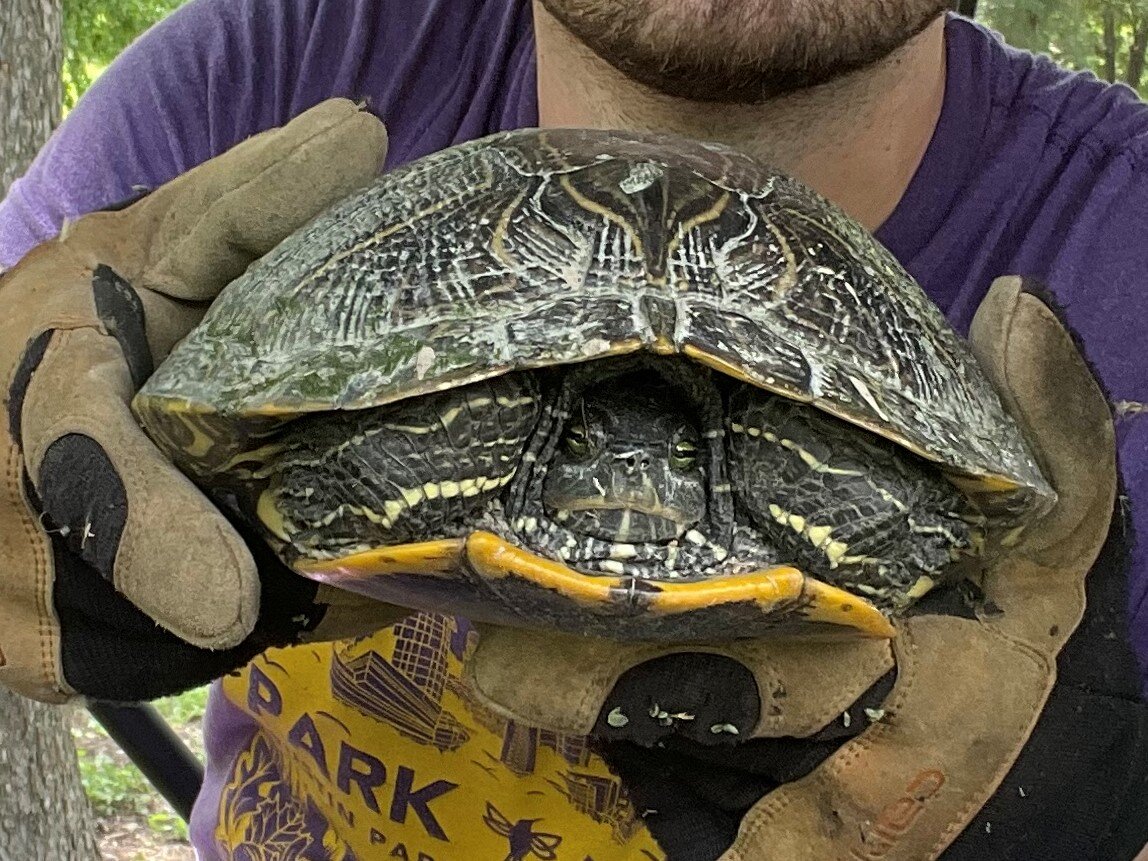

Texas River Cooter
Description:
The Texas river cooter is a relatively large turtle. They are green in color, with yellow and black markings that fade with age. Males can be distinguished from females by their longer tails, longer claws, and overall smaller size.
Scientific Name: Pseudemys texana
Diet and Habitat:
Interesting Fact :
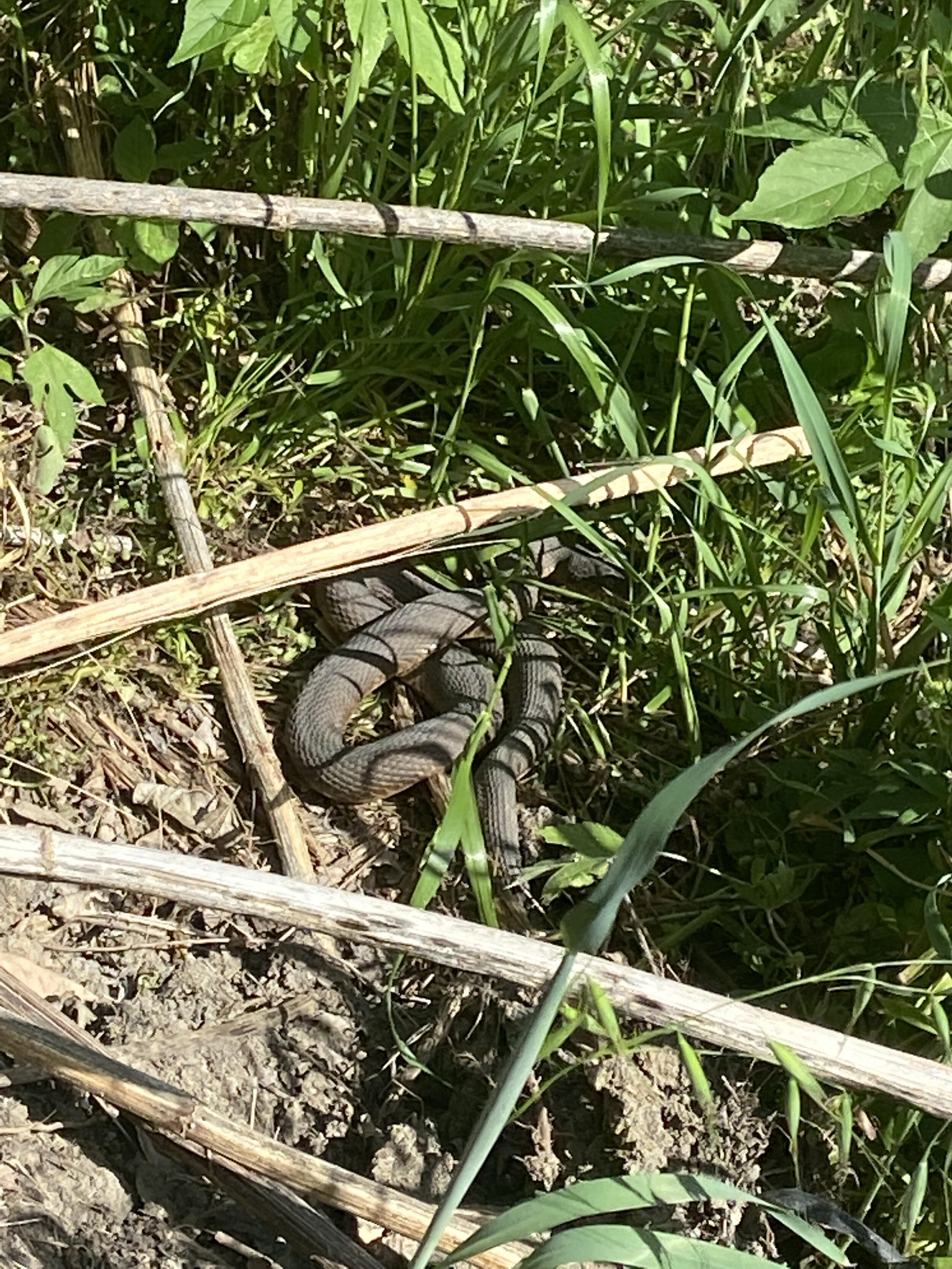
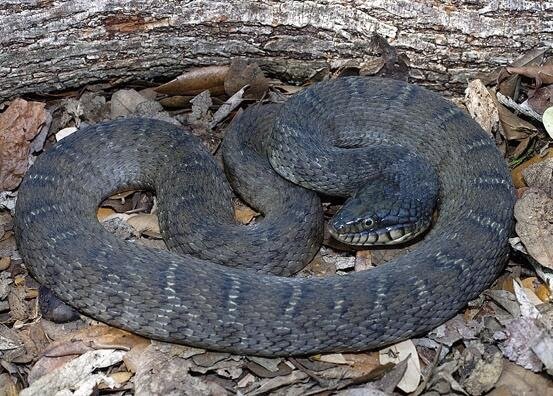
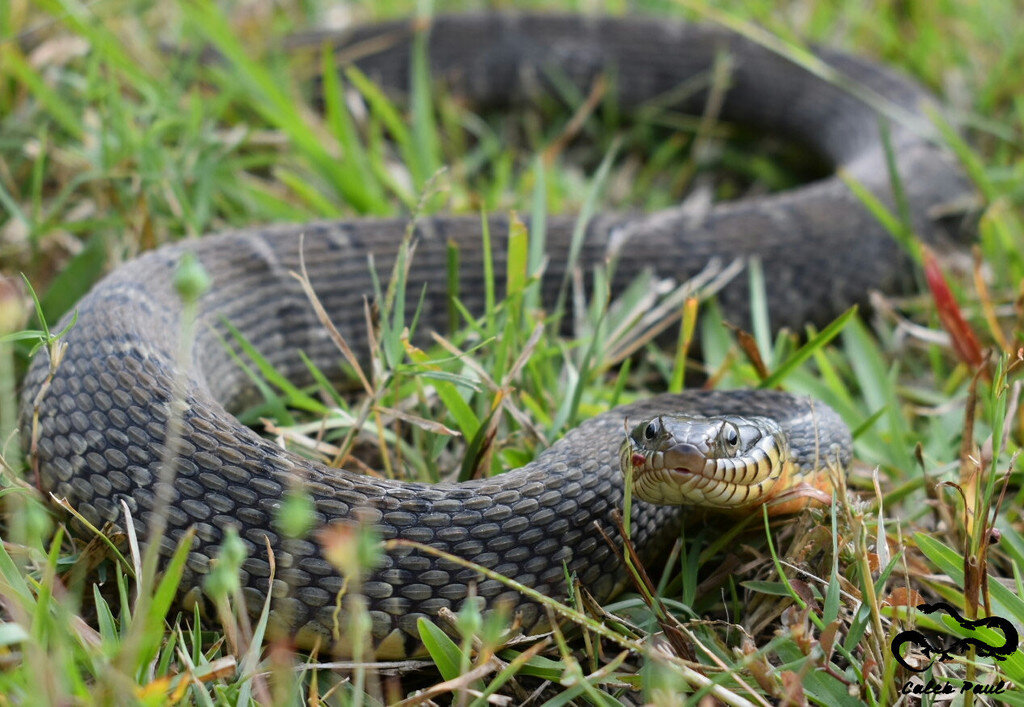
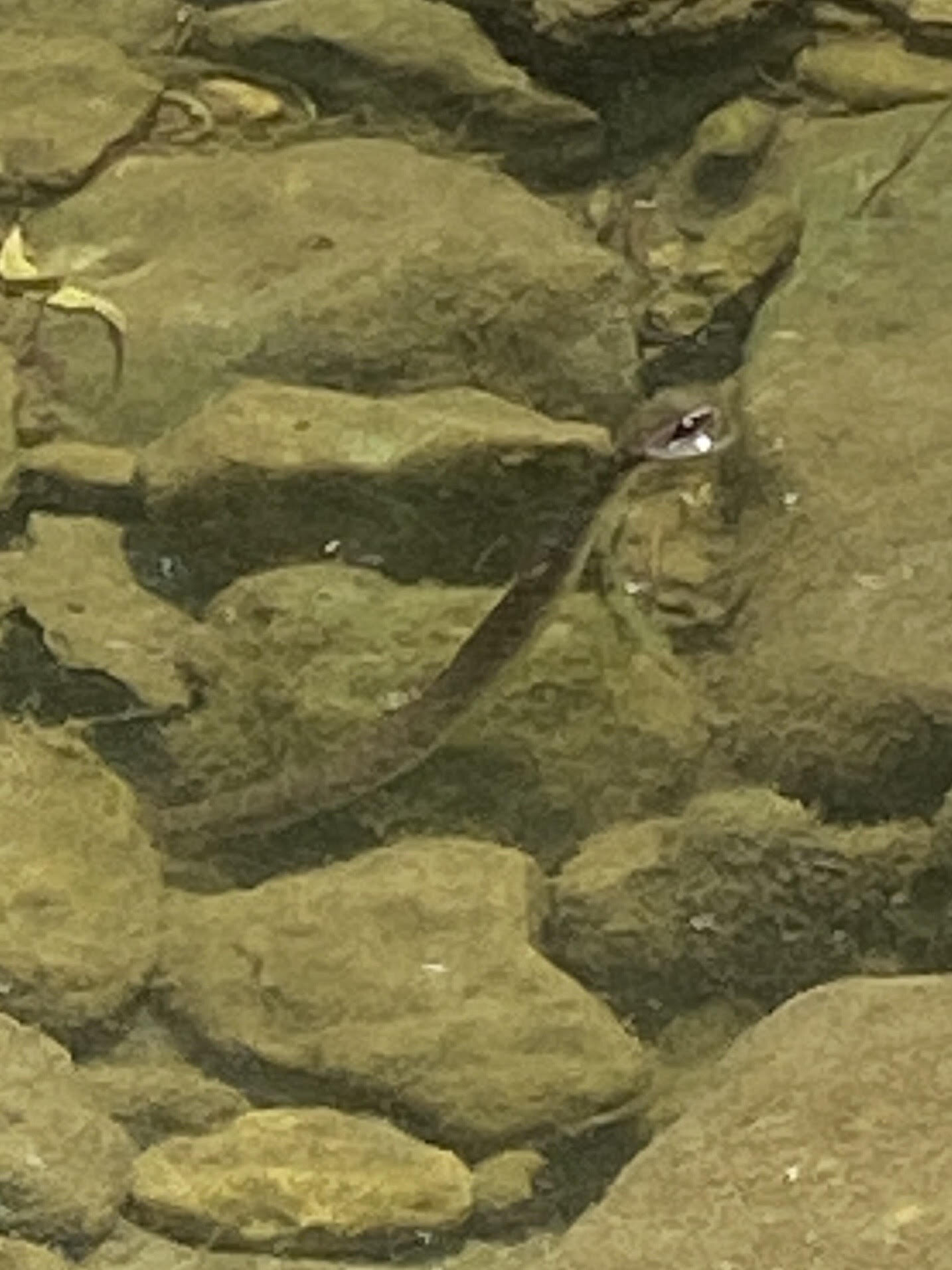
Plain-bellied Watersnake
Description:
The Plain-bellied Water Snake can be brown, gray, reddish, or brownish-black. It has dark crossbands on the neck and dark blotches on the rest of the body, often leading to misidentification as a cottonmouth or copperhead. As they age, their color darkens, and the pattern becomes obscure. Some individuals will become almost completely black. Their bellies also vary in color. They can be white, yellow, or gray. Usually, they also have reddish or black crescent markings.
Scientific Name: Nerodia erythrogaster
Diet and Habitat:
Interesting Fact :
Mammals:
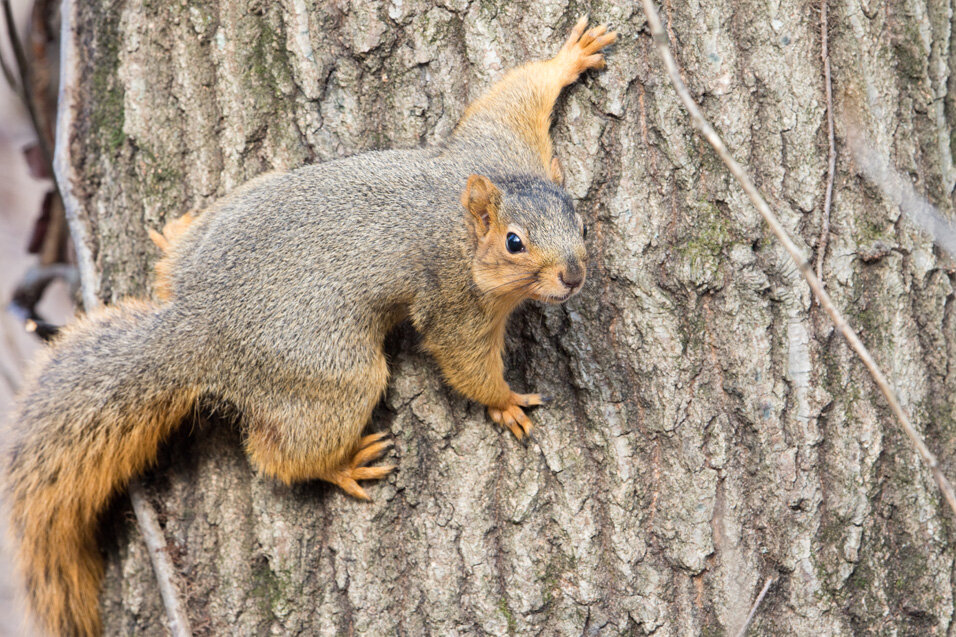
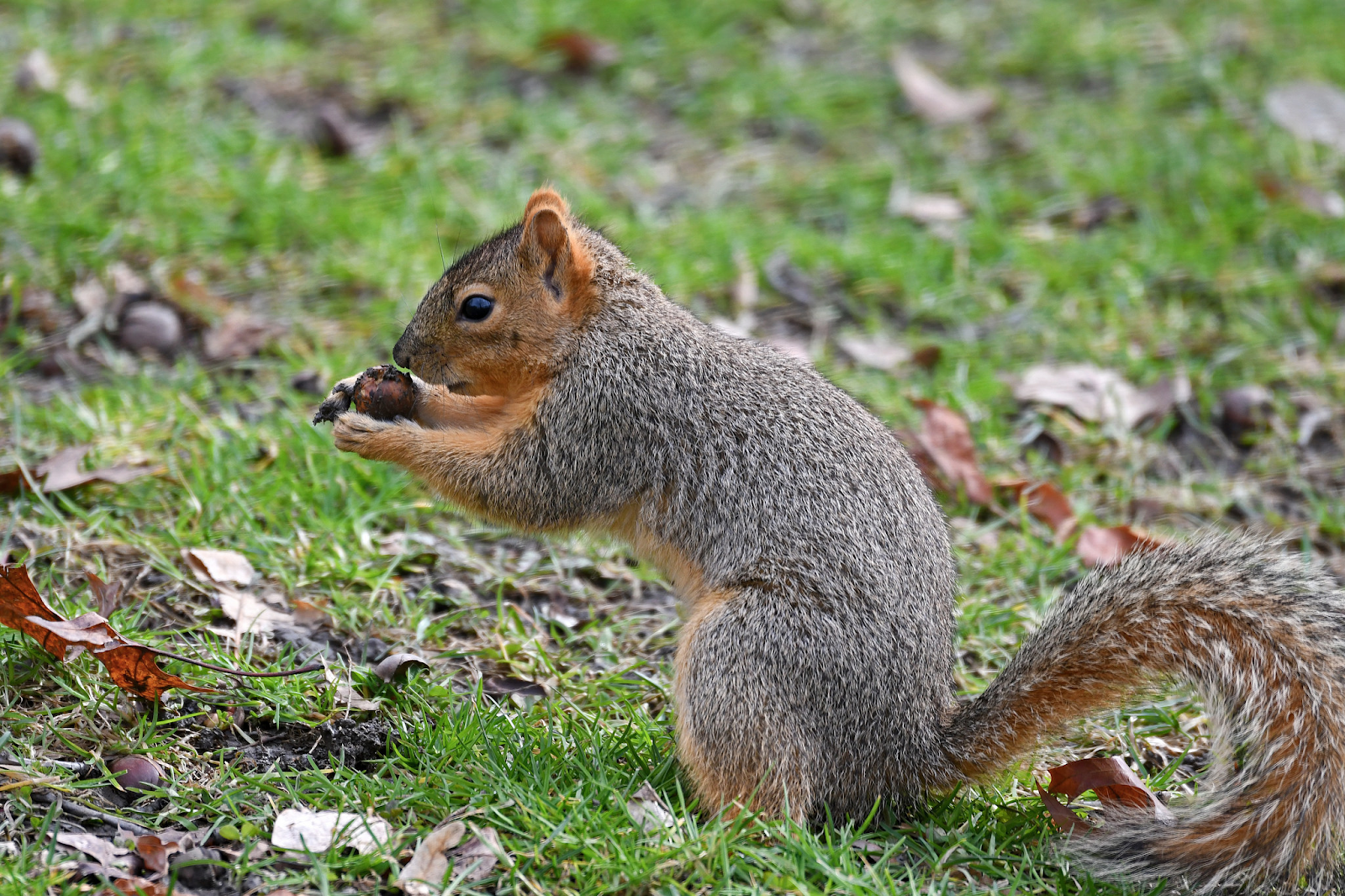
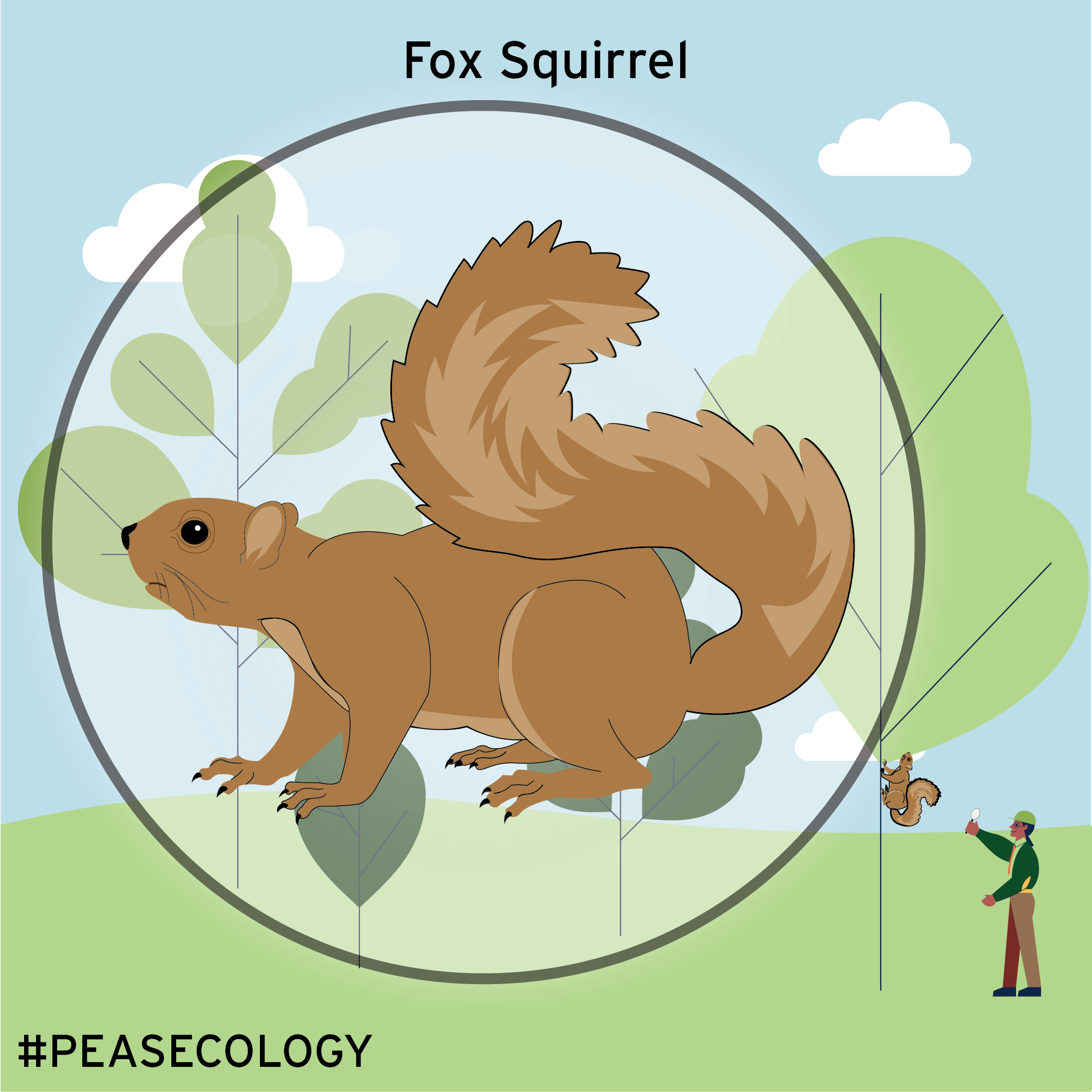
Fox Squirrel
Description:
Due to their ability to adapt to a wide range of forest habitats, Fox Squirrels are Texas' most common squirrel. It prefers an open, parklike woods where large mature trees shade the forest floor and prevent the under-brush from flourishing, but it can adapt to a variety of forest habitats. Fox squirrels got their name from their gray and red fur coats that resemble that of a gray fox.
Scientific Name: Sciurus niger
Identification:
Habitat and Distribution: Fox squirrels prefer upland hardwood forests containing nut producing trees. They're found in the forests and along the rivers and streams in the eastern two-thirds of Texas and the eastern half of the United States.

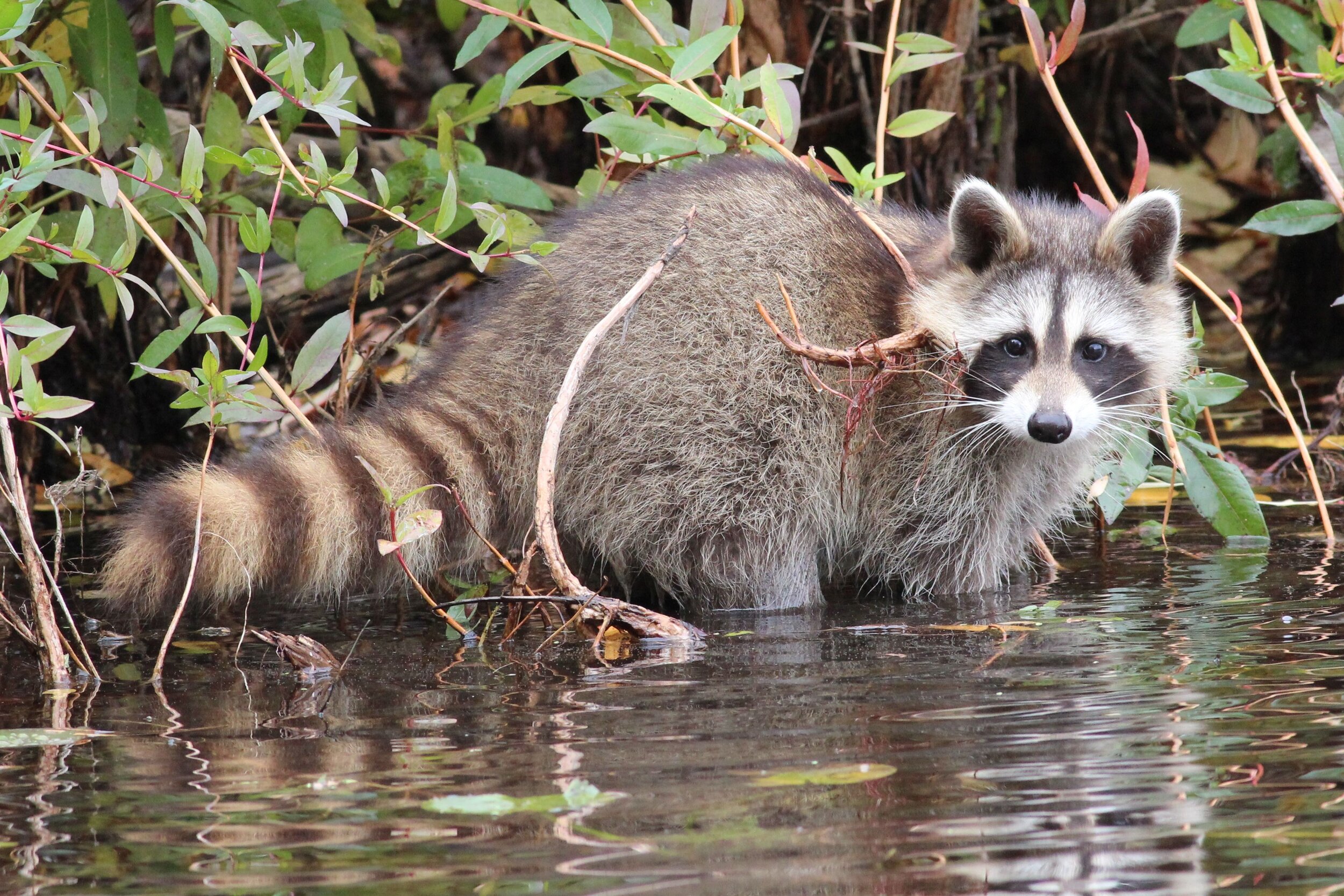
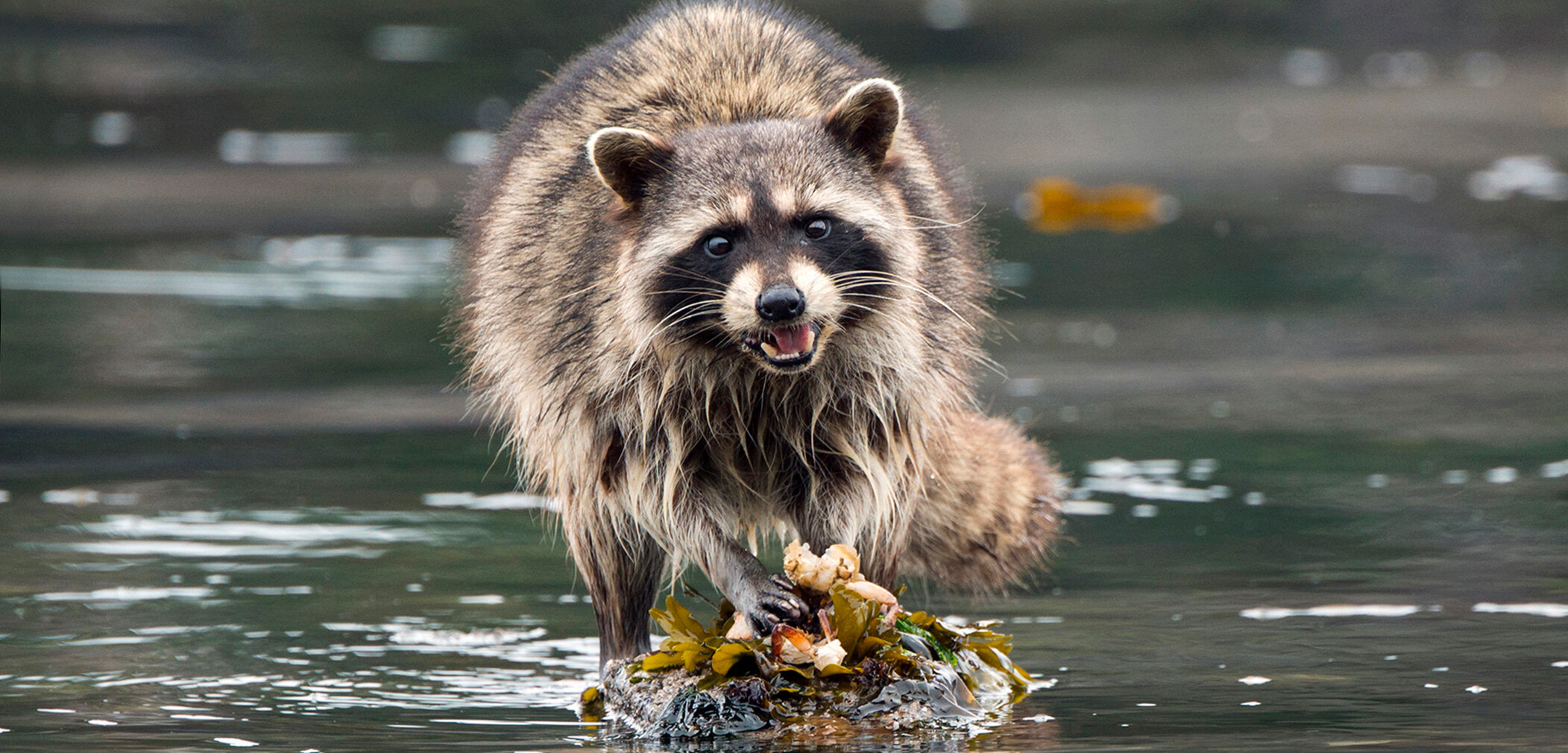
Common Raccoon
Description:
Its grayish coat mostly consists of dense underfur which insulates it against cold weather. Three of the raccoon's most distinctive features are its extremely dexterous front paws, its facial mask, and its ringed tail.
Scientific Name: Procyon lotor
Habitat and Distribution: The original habitats of the raccoon are deciduous and mixed forests, but due to their adaptability, they have extended their range to mountainous areas, coastal marshes, and urban areas.
Interesting Fact : In the wild raccoons are constantly foraging in water and rolling and handling their prey, which often looks like they are washing their food.
Coyote
Description:
The hair's predominant color is light gray and red or dull orange around the body and some black and white. Coyotes living at high elevations tend to have more black and gray shades than their desert-dwelling counterparts, which are more orange or whitish-gray. The coyote is typically smaller than the gray wolf but has longer ears and a relatively larger upper skull, as well as a thinner frame, face, and muzzle. The coyote also carries its tail downwards when running or walking, rather than horizontally as the wolf does. Coyote tracks can be distinguished from those of dogs by their more elongated, less rounded shape. A coyote is often mistaken for a fox.
Scientific Name: Canis latrans
Diet and Habitat: Anything from food scraps to deer, and small rodents. Coyotes will eat what they can find or hunt. Coyotes in Pease Park, however, tend to be on the small side, often malnourished and thus eat small prey or scraps from the garbage. Coyotes live in wooded areas and are known to take shelter under anything that can provide shelter.
Interesting Fact : Next to the Holarctic gray wolf and the Himalayan wolf, the Coyote is the third closest ancestral relative of the domesticated dog. Coyotes may occasionally form mutualistic hunting relationships with American badgers, assisting each other in digging up rodent prey. The relationship between the two species may occasionally border on apparent "friendship", as some coyotes have been observed laying their heads on their badger companions or licking their faces without protest.
Fish:
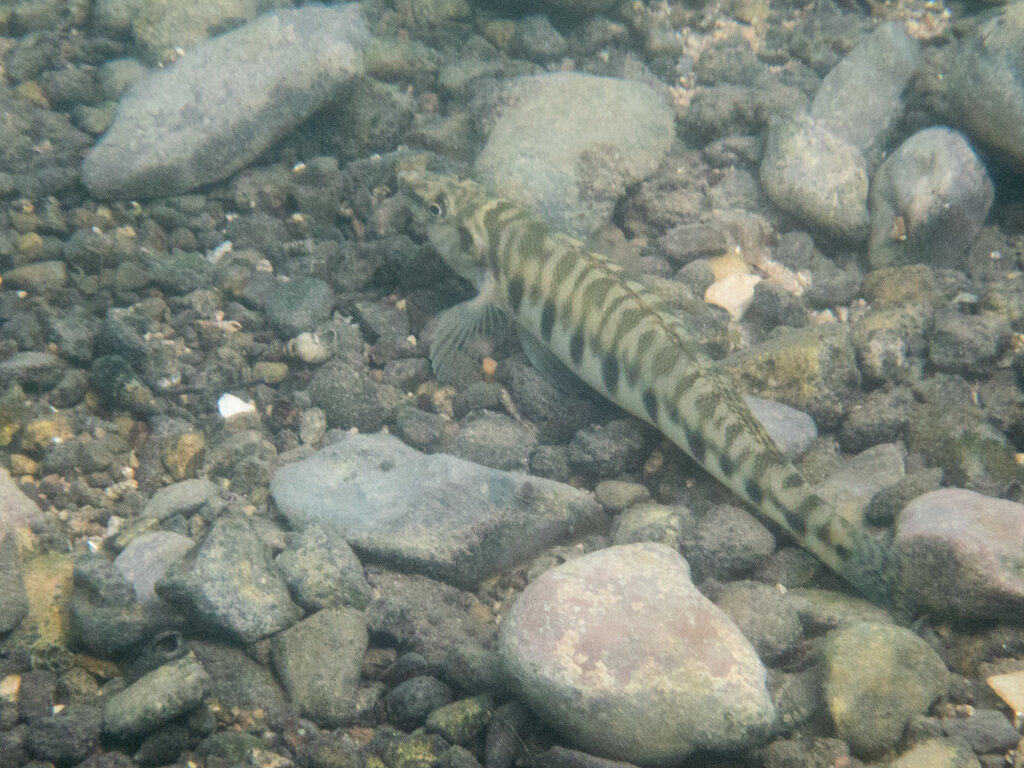
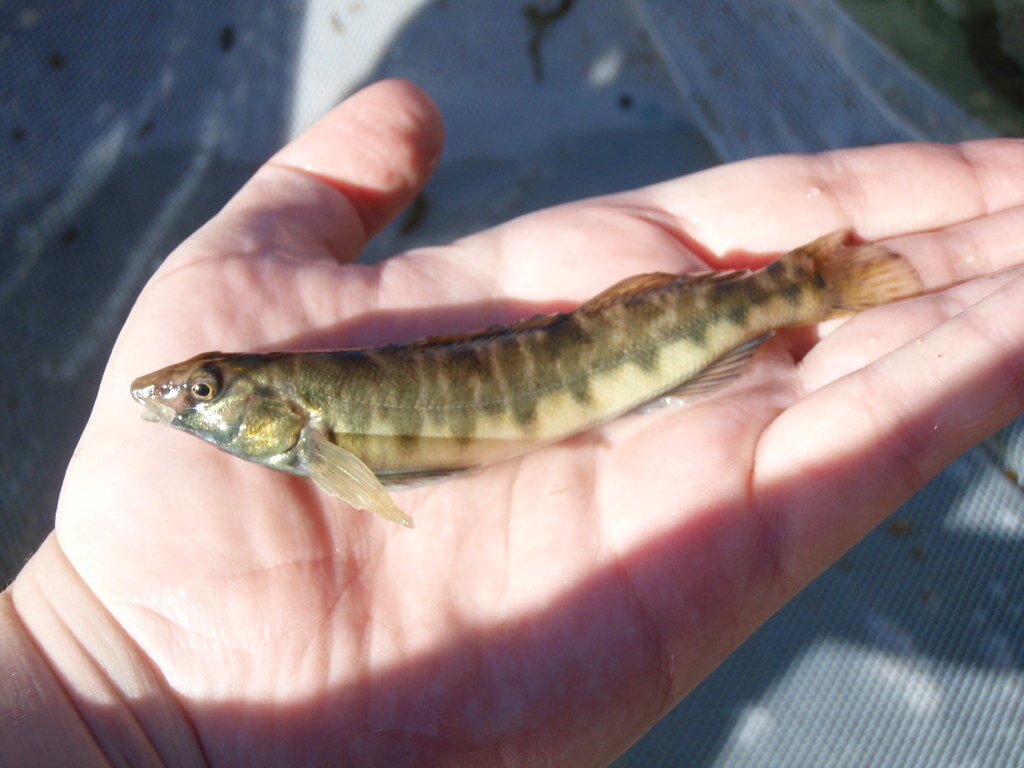
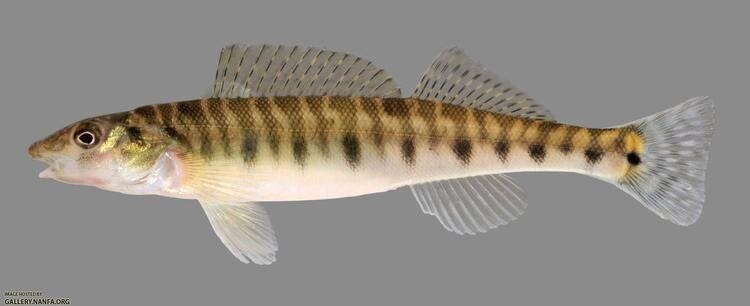
Texas Logperch
Description:
The Texas Logperch is a long, slender fish with yellow or olive-yellow scales and brown tiger-like stripes along its body. The Texas Logperch has a distinct black dot at the base of its tail. And a small snout, small mouth, and small eyes.
Scientific Name: Percina carbonaria
Habitat and Diet: Texas Logperch prefer clear, swift water with rocky or sandy substrate. Its diet consists primarily of invertebrates, which it hunts by flipping over stones with its snout. It appears that logperches are not especially picky when foraging and that they are actually very opportunistic feeders.
Interesting Fact : While the common logperch is not currently listed as a threatened or endangered species, humans should be aware of our negative impact on the species, and the ways in which we can minimize this impact; most notably, by limiting the construction of dams, increasing oxygen levels in the tailwaters of existing dams, limiting the number of predatory gamefish stocked, decreasing the amount of silt and debris deposited in streams, and monitoring nitrite levels in common logperch habitats.
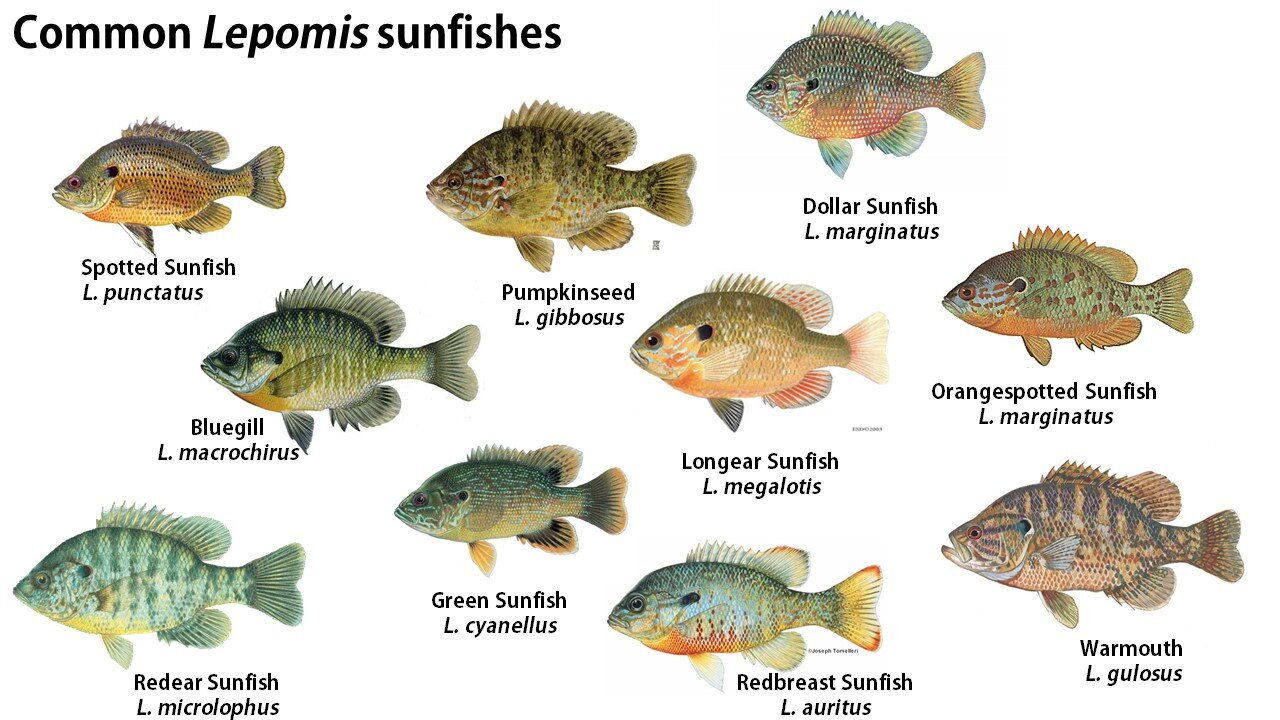
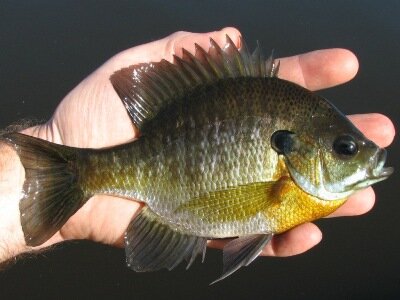
Sunfish
Description:
Centrarchid (sunfish) are a family of freshwater ray-finned fish. The centrarchid family comprises 38 species of fish, 34 of which are currently living, including the Orangespotted sunfish, Longear sunfish, Bluegill, Pumpkinseed, Green sunfish, and redear sunfish. All species in the family are native to only North America.
Scientific Name: Lepomis
Habitat and Diet: Sunfish prefer clear, warm, and slower-moving water, and are commonly found in habitats such as lakes, ponds, medium to low flow streams and rivers, and swamps. They also prefer to live in and around aquatic vegetation so they can get adequate coverage from predators. These fish primarily feed on small insect larva, small crayfish, and sometimes small fish or frogs.
Interesting Fact : Most sunfish are valued for sport fishing and have been introduced in many areas outside their original ranges, sometimes becoming invasive species. While edible, they are not commercially marketed as food fish.
Hazardous Plants:
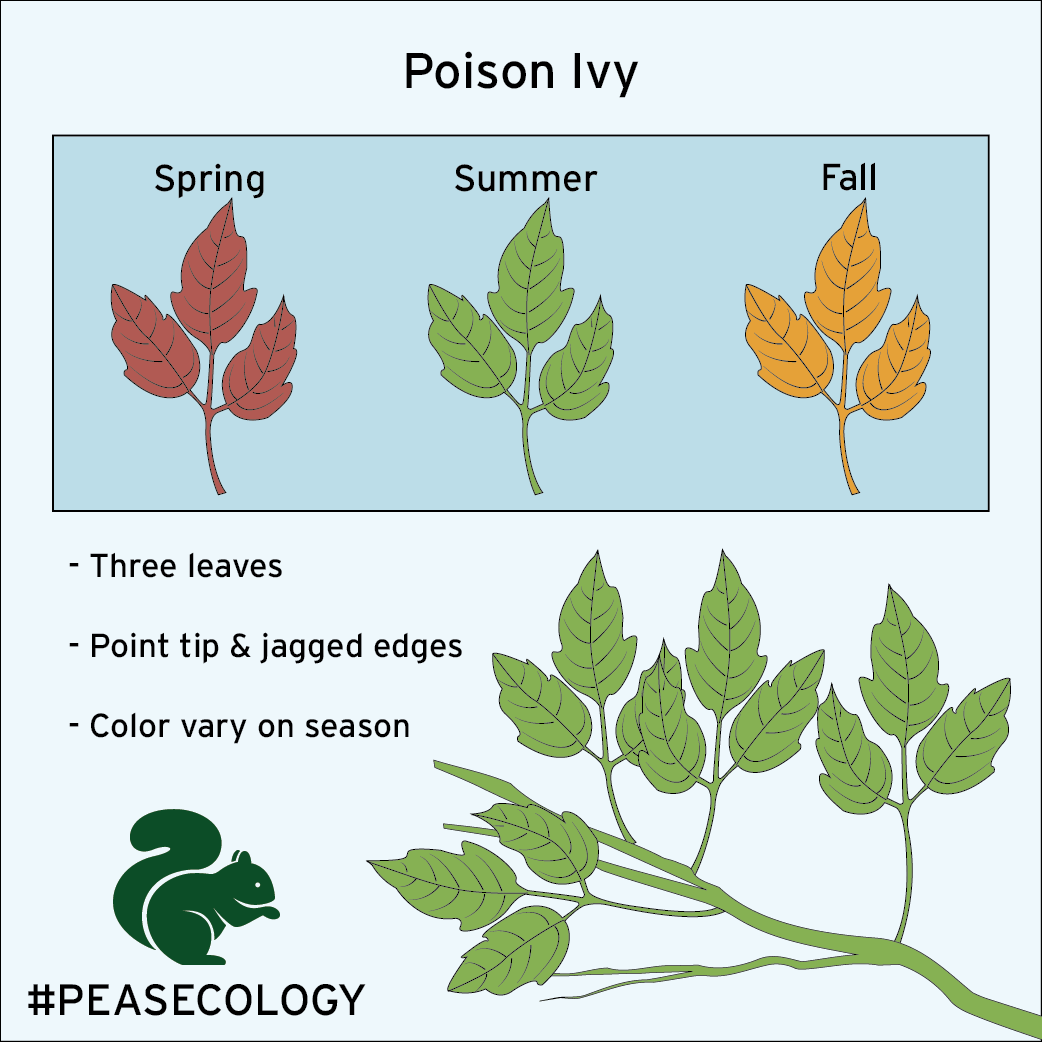
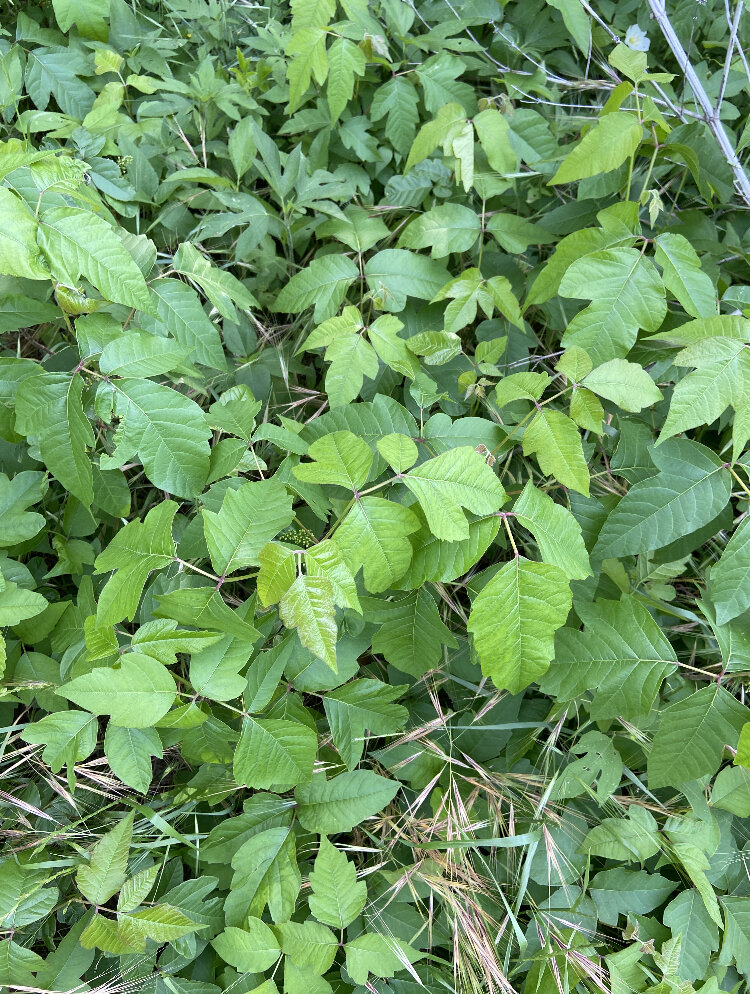
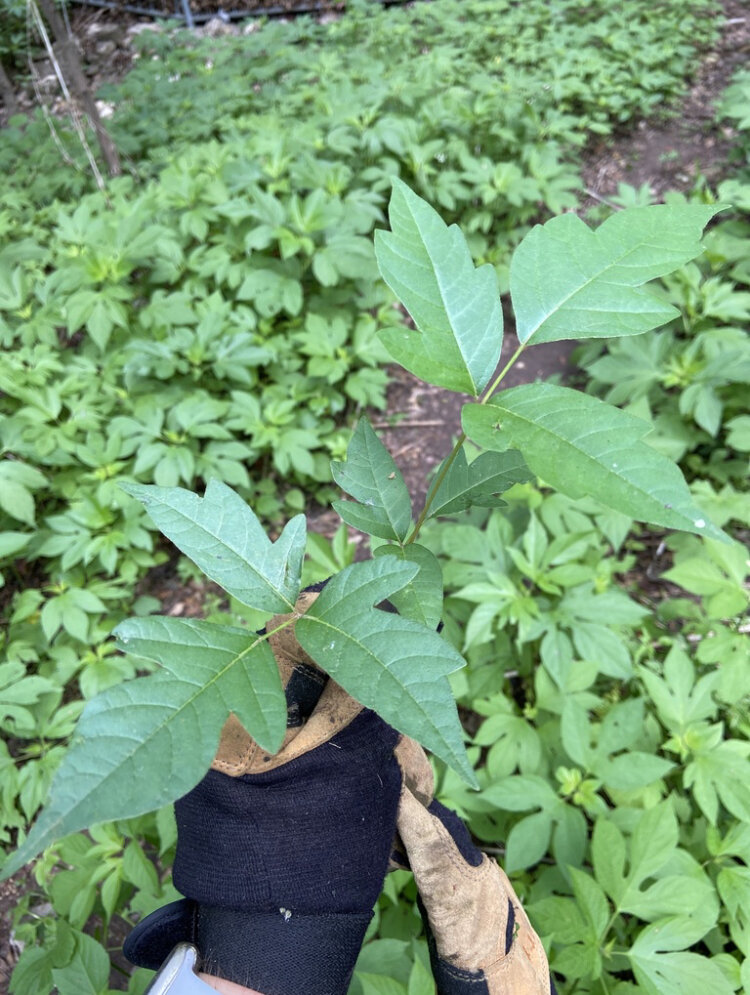
Source: Pease Park Conservancy
Poison Ivy
Description:
An allergen plant that takes the shape of three leaves with pointed tips and jagged edges, one on each side and one at the center. The middle leaf has a longer stem than two side leaves.
Scientific Name: Toxicodendron radicans
Colors:
- Red in Spring
- Green in Summer
- Yellow or Orange in Fall
Cautions: It’s best to avoid contact with Poison Ivy because they have a substance named Urushiol that will cause what we called Poison Ivy Rash. Once in contact with the plant, red blisters or streak of red like symptoms that cause serious itch will appear within 1-3 days and last up to 3 weeks.
Additional Information at:
Follow our social media to keep updated:


